MONTEREY BAY














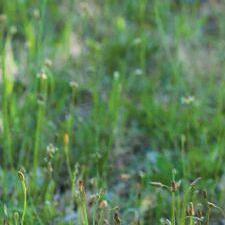
®
Fall 2017 • Number 25 edible
Member of Edible Communities APPLES VEG ON THE EDGE SALT WOOD FOLKTALE • FOODLAB WINTER SQUASH & PUMPKINS WATSONVILLE FRONT & COOPER
Celebrating the Local Food and Drink of Santa Cruz, Monterey and San Benito Counties

















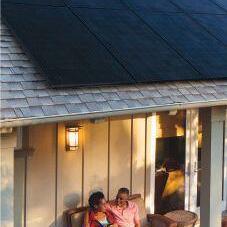



32
EDIBLE COMMUNITY WATSONVILLE AWAKENING
DINE LOCAL GUIDE
NOTABLES




e cooks are kids at FoodLab, Veg on the Edge pushes the envelope on healthful and delicious food, Folktale Winery becomes a local hotspot for food as well as wine 19
Are hipster food and drink businesses making it the Brooklyn of the Monterey Bay? 40 ON THE FARM FORGOTTEN FRUIT
LOCAL SOURCE GUIDE 72
LAST CALL A WOMAN AND A VAMPIRE WALK INTO A BAR
WHAT’S IN SEASON
WINTER SQUASH AND PUMPKINS
Discover some delicious new variations on these fall favorites 25 FOODSHED
FALL FARMERS’ MARKETS
A complete guide for the Monterey Bay area 28
EDIBLE HEIRLOOMS TIME TRAVELERS
Santa Cruz County’s culinary heritage is served up in a tasty new book
Heirloom apple growers and cider makers breathe new life into historic crop 48

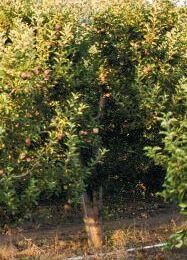
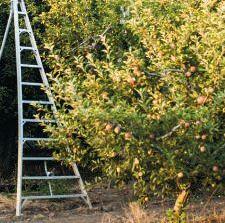
BACK OF THE HOUSE ROAD TRIP
Chef David Baron gets to know his farmers and fishermen as he prepares to open his much-anticipated Salt Wood restaurant in Marina 54
THE PRESERVATIONIST GIVING TREE
Savor autumn’s luscious bounty of figs year-round
World champion bartender Kate Gerwin stirs up cocktail culture in Santa Cruz
COVER PHOTOGRAPH

Ellery Hansen reaches for an apple
By Michelle Magdalena
CONTENTS PHOTOGRAPH Orchard at Fruitilicious Farm By Michelle Magdalena

RECIPES IN THIS ISSUE: 22 Butternut Squash Farrotto 23 Butternut Squash Crème Brûlée 31 Tomato Apple Chutney 47 Apple Upside Down Gingerbread 55 Fig Jam

2 edible MONTEREY BAYFALL 2017
4 GRIST FOR THE MILL 6 EDIBLE
Contents
57
69

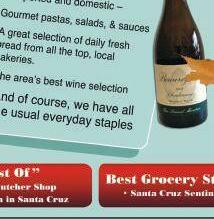







www.ediblemontereybay.com 3
GRIST FOR THE MILL
On a bright summer evening this past July, we were walking across London Bridge when we noticed some young Londoners coming from the direction we were headed, engrossed in happy conversation and drinking glasses of beer as they walked. By the time we reached the other side, we felt an exciting energy all around us. How had we forgotten? We were in Southwark, the location of the famous Borough Market! With a history that some believe dates back to the year 1014, it’s known as London’s oldest produce market and boasts more than 100 food stalls.
Poignantly, this was also the site of a horrendous terrorist attack in June, but just weeks later the market was completely unbowed: tantalizing smells from the restaurants that surround it and the sounds of jubilant and gregarious Londoners spilling out onto the sidewalks filled the twisting streets. When we returned to see the market in its fully glory during daytime hours, we found a sea of humanity speaking diverse languages, some wearing religious garb, of all ages and yet with a common pursuit of seeking out England’s best farmers, fishermen, brewers, butchers, bakers and other food purveyors. Food is life, and at Borough Market, life wins.

is fall edition of Edible Monterey Bay, so beautifully edited by EMB deputy editor Deborah Luhrman while we were away on sabbatical, is brimming with celebration of the local food growers, creators and purveyors that infuse so much life into our own communities.
In her story, Debby describes the Food Heritage Project’s remarkable new book that tells the histories of 11 foods that were grown and prepared during Santa Cruz County’s early days, with recipes from some of the area’s earliest cooks.
Jamie Collins shares the story of pioneering local farmers who are capitalizing on new tastes for hard cider and local, organic apples to bring back the region’s once plentiful orchards.
Meantime, Watsonville resident Elizabeth Hodges explores the creative energy bursting from her town’s food and drink scene, arguably transforming it into something of a Brooklyn of the Monterey Bay area.
Also in this issue, our writers show how several new local food and drink ventures are having an exciting impact on their own communities. Rosie Parker takes you on an odyssey with David Baron, chef at the new Salt Wood restaurant in Marina; Camilla M. Mann tells the story of the playful masterminds behind Folktale Winery in Carmel Valley; and Elizabeth Limbach introduces the bartender who brought us Front & Cooper in Santa Cruz’s new Abbott Square complex.
We hope your autumn is filled with inspirational adventures, whether to some far-flung corner of the earth or right here within our dynamic tri-county area.
As always, we’d like to close with a huge and warm thank you to our wonderful staff, contributors and advertising partners, without whom this magazine would not be possible!
Cheers,
Wood and Rob Fisher Publishers
MONTEREY BAY
PUBLISHER AND EDITOR
Sarah Wood Sarah@ediblemontereybay.com 831.298.7117 or 831.238.1217
CO–PUBLISHER AND ASSOCIATE EDITOR Rob Fisher
DEPUTY AND DIGITAL EDITOR Deborah Luhrman
COPY EDITOR Doresa Banning
LAYOUT DESIGN Melissa Petersen
SOCIAL MEDIA MANAGER Katie Reeves
EDITORIAL ASSISTANT AND EVENTS MANAGER Rosie Parker
AD DESIGN Bigfish Smallpond Design
Dina Clark • Jane Bolling Design • Kjeld Petersen
Zephyr Pfotenhauer • Marilet Pretorius Melissa oeny Designs
CONTRIBUTORS Crystal Birns
Nika Cassaro • Jordan Champagne
Jamie Collins • Julie Fineman • Ben Halley
Elizabeth Hodges • Elizabeth Limbach
Deborah Madison Michelle Magdalena
Camilla M. Mann • Ryan Morris • Rosie Parker
Zephyr Pfotenhauer • Michael Santaella
Laurie Smith • Zea Sonnabend • Lily Stoicheff Carole Topalian • Patrick Tregenza
Amber Turpin • Patrice Ward • Kenny Woods
ADVERTISING SALES

ads@ediblemontereybay.com • 831.238.1217 Shelby Lambert shelby@ediblemontereybay.com Kate Robbins kate@ediblemontereybay.com Sarah Wood sarah@ediblemontereybay.com
DISTRIBUTIONMANAGER Mick Freeman
CONTACT US:

Edible Monterey Bay P.O. Box 228, Carmel Valley, CA 93924 www.ediblemontereybay.com 831.298.7117 or 831.238.1217 info@ediblemontereybay.com
Edible Monterey Bay is published quarterly. All rights reserved. No part of this publication may be used without written permission of the publisher. Subscriptions are $28 per year at www.ediblemontereybay.com. Every effort is made to avoid errors, misspellings and omissions. If, however, an error comes to your attention, please accept our apologies and notify us. We also welcome letters to the above address. ank you.
4 edible MONTEREY BAYFALL 2017
Sarah
edible


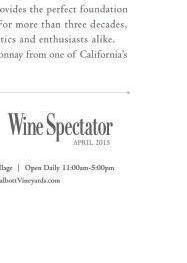
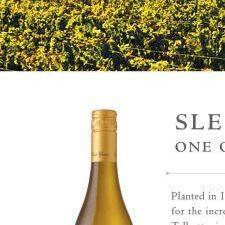


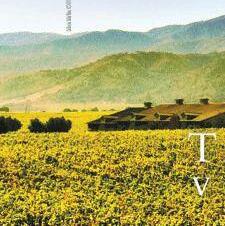





EDIBLE NOTABLES FOODLAB
As kids head back to school, the students will be doing the cooking in a pioneering lunch program at Pacific Elementary
BY LILY STOICHEFF PHOTOGRAPHY BY MICHELLE MAGDALENA
It’s lunchtime at Pacific Elementary School in Davenport and the kitchen is a flurry of activity. e lower grades have finished eating already and the upper grades will be sitting down at the low blue gingham-covered tables within the hour. By that time the marine layer will likely have burned off, allowing the children to enjoy stunning views through the ocean-facing windows.
In the kitchen, one of the cooks fluffs a huge pot of brown rice with a fork, releasing warm, nutty plumes of steam. Another calls out, “Opening oven!” and checks the roasted chicken thighs for doneness, spooning over a little more of the garlic, Dijon mustard and balsamic sauce. A third stands on a stool as she deveins large leaves of romaine lettuce, expertly guiding a chef’s knife as long as her slender forearm along the tough stem and chopping it into pieces easily pierced by smaller forks.
ese young chefs are fifth and sixth graders at Pacific Elementary, and this kitchen is the FoodLab, the cooking component of the nonprofit Life Lab garden classroom where students cook the lunches for all students and staff. Before graduating to the kitchen, kindergarteners through fourth graders spend an hour a week in the nearby garden learning about composting, planting, harvesting and seasonality. By being deeply involved in growing and cooking their food, the children become invested in what they eat.
Founded in 1984 by Stephanie Raugust, FoodLab is just as groundbreaking and unique today as it was 33 years ago. Unlike other schools where working in the kitchen may be an elective option, if the opportunity is presented at all, every student cooks in the FoodLab every week as part of the school’s curriculum. Four-student teams rotate the roles of prep cook, baker, cook and manager, so everyone has the opportunity to perform a variety of kitchen tasks and leadership roles. “We’re educating the whole student, not just the academic part,” explains food services director Emelia Miguel.

Ten years ago the FoodLab program influenced her and her husband’s decision to enroll their daughter in Pacific Elementary. After several years of volunteering in the kitchen, she took over the full-time position four years ago when Raugust retired.
With the help of her second-in-command, FoodLab instructor Violeta Law, Miguel manages the kitchen with a warm, assertive presence, demystifying a traditionally grown-up realm. “We start our year with a scavenger hunt because I feel like if you’re in the kitchen and you don’t know where everything is, it’s really hard to cook,” she says.
“For knife skills, we always teach them the claw,” adds Miguel, positioning her hand so that if she were to hold a knife, the blade would avoid her fingertips. “It’s interesting because they come from such different places, but we want them to end up in the same place with basic

6 edible MONTEREY BAYFALL 2017
Unlike other schools where working in the kitchen may be an elective option …every student cooks in the FoodLab every week.
FoodLab food services director Emelia Miguel with a student





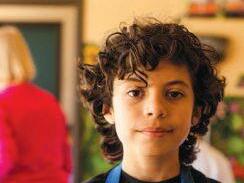
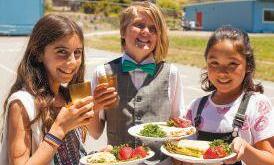
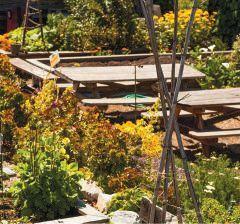

www.ediblemontereybay.com 7
FoodLab instructor Violeta Law, 4th from left; founder Stephanie Raugust, 4th from right; and food services director Emelia Miguel, 2nd from right, with students
skills like how to use a knife. We don’t do anything fancy. It’s pizza. It’s hard-boiled eggs, salad, roasted chicken.”
e wholesome menu adheres to standards set by the USDA National Student Lunch Program and Miguel also incorporates family recipes from students. Today the students make Ondine’s Baked Chicken, and the sixth grader guides her teammates and Miguel on its preparation. Earlier, the team worked out how to multiply the original recipe to feed nearly 100 people.
Miguel says seeing the students empowered and knowing she can trust them in the kitchen to do such a huge job is the most rewarding result of her work. “I think that’s why a lot of other food services directors don’t do this. ey don’t have the same amount of trust in their students. ey think those jobs need adults, but they don’t realize that kids can do it just as well, and with more creativity and enthusiasm and more willingness to get the jobs done. It’s pretty amazing.”
FoodLab’s success is evident not just in the skills learned by the students, but also in the number of lunches sold. “We have an 82% participation rate in our lunch program, which is extremely high for a school, and we have a pretty low percentage for free and reduced price school lunch—around 37%,” explains Miguel. “Normally what you see is a high free and reduced price lunch percentage and a high participation rate, because they have a captive audience of kids who can get lunch for free. For us to have such a high participation rate with a low free and reduced lunch rate shows that parents are choosing to purchase school lunch for their kids because they know it’s a good, healthy option.”
However, because the FoodLab has chosen to use only organic produce, milk and eggs, and sustainably raised meats, and despite stringent cost-saving measures, the funding it receives as a public school from the state and federal government falls woefully short each year. To help fill the gap, it hosts an Outstanding in the Field-style farm dinner at Green Oaks Farm in Pescadero each fall. is year, it will be held on October 7. “We make most of our money in the sale of the tickets. Students and families come in and create and cook. Foodie people come in and make the menu, and we have really amazing, yummy ideas,” says Miguel.
Back in the kitchen it’s almost time for the second seating. Miguel answers a hundred eager questions from inquiring minds and tells students it’s time to begin plating. Raugust frequently visits her beloved program and today she takes a few seconds of Miguel’s time to inspect a basket of fresh fava beans—Raugust thinks shelling them would be a good task for small hands. e enticing aromas wafting from the centrally located kitchen draw hungry students and teachers, who eat together at the lunch table. Miguel explains, “It’s literally the heart of the school.”
Lily Stoicheff is an eater and writer living in Santa Cruz with a soft spot for points of historical interest and a passion for pickles that threatens to take over her fridge.






EXPLORE: To learn more about the FoodLab at Pacific Elementary School in Davenport or purchase tickets for its fundraising dinner, go to www.pacificesd.org/foodlab.html.

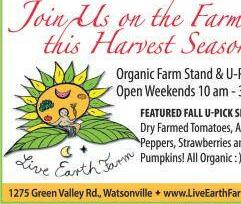


8 edible MONTEREY BAYFALL 2017



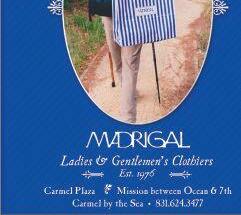
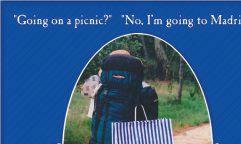
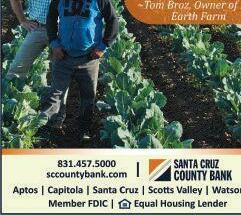



www.ediblemontereybay.com 9

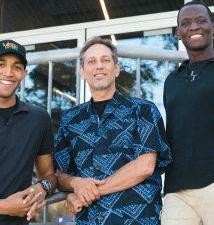



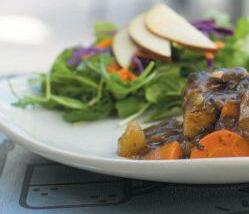




10 edible MONTEREY BAYFALL 2017
From left: Deji Bankole, Eli Cohen and Akindele Bankole
Moin Moin, a West African-inspired dish
EDIBLE NOTABLES
VEG ON THE EDGE
West African, kosher, vegan and delicious
BY ROSIE PARKER PHOTOGRAPHY BY CRYSTAL BIRNS
Akindele Bankole has infectious energy, the warmest smile and an ageless quality that makes you want to say, “I’ll have what he’s having.” Luckily, this is entirely possible since Bankole is at the helm of Veg on the Edge, the newly opened Abbott Square eatery in downtown Santa Cruz. Originally from Nigeria, Bankole came to the States in 1982 to pursue a music degree at Sacramento State. He went on to have an 11year career as an opera singer, performing with the Sacramento Opera and Opera San Jose. But the job that influenced him most in starting Veg on the Edge was Bankole’s 25-year career with McDonald’s. “It was a great experience,” he says. “Truly!” e company taught him the value of systems in achieving consistency, cleanliness and customer service. “Many ex-employees,” he explains, “have taken what they learned and applied it to a more health-conscious establishment.”
Veg on the Edge started to take shape more than three years ago when Bankole decided to pursue his entrepreneurial passions with a business that combined healthy food, education and community. Working with husband Eli Cohen (an ex-public defender and ordained rabbi who leads Chadeish Yameinu, the Jewish Renewal Community of Santa Cruz), Bankole’s son Deji (in charge of advertising and marketing with a background in film) and longtime family friends, Lynn LeRose and Edward Garner, they started to put together a business plan.
“We are an international group with multiple languages under our belt,” Bankole reflects. “I think we are a real representation of what it can mean to be an American. We get to honor everyone’s roots and stay true to who everyone is.” For Bankole, this means having West African influences on the menu. For Cohen, this means becoming cer-
tified kosher. And for the whole family, this means being a vegan, gluten-free eatery that engages with the holistic community and provides educational outreach.
“We want to be a positive educational statement in the community. People only make changes when they know people care about them. I don’t want to condemn,” Bankole stresses. “For me, a foundational value for Veg on the Edge is compassion. It’s only through compassion that we can enact change.”
“It’s about emphasizing choices,” Cohen further explains, “not about people doing right or wrong. As a vegan, I often feel that my options are limited, so we simply want to provide more options for our community.”
About two years ago Bankole enlisted the help of chef Jonathan Miller to start planning the innovative menu. Miller has worked for more than 15 years mostly as a private chef, with clients ranging from former
www.ediblemontereybay.com 11
“I think we are a real representation of what it can mean to be an American.”
UCSC chancellor M.R.C. Greenwood to celebrities Charlize eron and J.J. Abrams. From his base in Santa Cruz County, he now offers his custom services through the website, www.eatrightathome.com.
Far from the bland, colorless dishes often associated with vegan food, Veg on the Edge has a menu built on bold flavors and innovative fusions. Moin Moin, a classic West African dish, is a black-eyed pea loaf that absorbs the spiced broth of a mushroom and carrot stew. Another West African-inspired dish is the raw plantain salad—a vibrant burst of color and crunch with zucchini, bell peppers, summer corn, tempeh crumbles and a tangy mustard dressing to balance the earthy sweetness of the sliced plantains.
Edgier interpretations of more classic vegetarian options include shiitake fried rice, made with “forbidden” black rice that has a rich, nutty flavor. eir signature potato balls, which Bankole confesses took three months to perfect, are the perfect healthy-ish snack of crispy-onthe-outside, soft-on-the-inside red potatoes with onions and mustard seed, held together with chickpea flour and served with chili sauce. Each dish is hearty, but not heavy, with generous portions at a reasonable price (entrées top out at $12.50 and come with a house salad and side of potato balls).
Veg on the Edge helps round out a diverse list of food vendors at the newly opened Abbott Square Market. It shares the space with Santa Cruz favorites like Cat & Cloud Coffee and Companion Bakeshop, as well as newcomers Poke It, Pizzeria La Bufala, oyster bar All Aboard, ice cream bar makers Milk and Wood and two bars (see story page 72).
After developer John McEnery had Bankole and Miller cater an investor party, he was blown away by the complexity of their vegan fare. “I think they’re the perfect fit,” he says. “ey’re unique, offering something different to the patrons of Abbott Square as well as the community at large.”

On a thriving First Friday in July at the square, only two days after Veg’s soft opening, Bankole is busy in the kitchen, a contagious smile on his face. “e first day was overwhelming, so much love and support from our community, far and wide. We weren’t expecting everyone to come out that day,” he says with a laugh, acknowledging that this is a good problem to have. “But I decided something,” he says, positivity beaming. “I’m just going to be happy here. is brings me so much joy, so joy is what I should feel. And I hope everyone else feels it too.”
Rosie Parker, a native New Englander, likes to complain of missing home while living the Santa Cruz high-life—surfing, hiking, writing and working for a delicious craft brewery.




Veg on the Edge
Abbott Square Market, Santa Cruz 530.312.0790 • www.vegontheedge.com

12 edible MONTEREY BAYFALL 2017
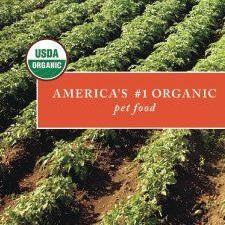


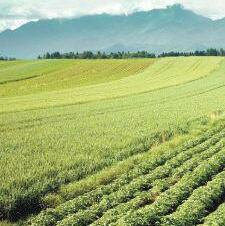
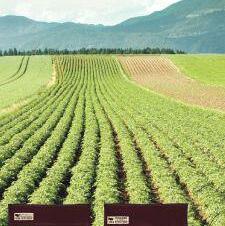







EDIBLE NOTABLES DREAMCATCHER
Folktale Winery is becoming a local hotspot for food as well as wine
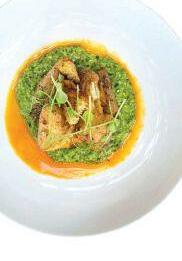 BY CAMILLA M. MANN PHOTOGRAPHY BY PATRICE WARD AND CAMILLA M. MANN
BY CAMILLA M. MANN PHOTOGRAPHY BY PATRICE WARD AND CAMILLA M. MANN
and
Once upon a time—not so long ago—there was a pretty French chateau surrounded by vines next to a sleepy river. Even though it was not for sale at the time, Greg Ahn took one look and could see the potential. “e property was beautiful, but you couldn’t tell from the road,” he recalls. “It didn’t feel welcoming.” He envisioned turning it into a smallbatch boutique winery and creating a vibrant cultural space and community hub on the estate. ree years later, he is well on the way to making that dream come true.
Ahn, founder and president of Folktale Winery & Vineyards in Carmel Valley, says it’s still a work in progress, fueled by people like hospitality vice president John Fitzgerald, who creates a welcoming vibe, and chef Todd Fisher, who was brought in earlier this year to direct culinary operations. Fisher says the property, winemaking and food are always developing and changing, “at is what makes Folktale fun and fresh.”
Folktale was inspired by the idea of stories—stories of people, places, life, love, laughter, nature, passion and celebration. Even the corks have stories printed on them.
While the atmosphere is playful, it’s also purposeful and stories are found everywhere around the 15-acre property, which includes the original residence and winery, a barrel room, greenhouse, gallery and wine garden. In the garden, tiny tables that support no more than a wine glass are repurposed from legs from a hefty table. African juju headdresses—a symbol of wealth and power—adorn a wall in the
gallery. And shutters from a local 19th-century house have been installed to provide shade in the airy, glass-enclosed space called e Greenhouse.
Hospitality manager Erin Maxey, who has been with Folktale since the beginning, speaks admiringly of Ahn, calling him a dreamcatcher. Dreamcatchers attract dreams to their webs; the bad dreams get tangled up while the good dreams pass through. Ahn lets people’s dreams take the lead.
at’s how he came to create Talking Animals recording studio with Mark Governor. e original residence on the property, the River House, now hosts a place for professional musicians to record their work. About the name, Ahn says, “All animals seem to talk in folktales.”


e property holds a myriad of events in that spirit of community and generosity. When people pitch an idea, Ahn usually answers, “Let’s make it happen.” at’s how a concert series, cooking competition and other events were born.
Local radio stations partner with Folktale to host musicians in Live in the Vines and the Wine Country Concert Series. e barrel room, a 10,000-square-foot space stacked floor to ceiling with more than 1,000 wine barrels, also houses the Chef Duel, a Food Network-style throwdown in which local chefs compete to advance to the next round.
Folktale presents an Artisan Workshop Series, in collaboration with Carmel Valley Mercantile and Tacklebox Creative, where students can learn about terrarium building, brush lettering, flower pressing and more. And every Saturday, Esalen Institute’s Kate Balog leads a 90minute “Yoga in the Vines” session in the rose vineyard. All classes include a glass of Folktale wine.
With all these activities, you might think Folktale’s plate is overflowing. However, there is more on the horizon. It’s that “let’s make it happen” attitude that led chef de cuisine Danny Leach to join the team where he’s been collaborating on the new menu for e Greenhouse.
Chef Todd is excited about the offerings, explaining, “e new menu centers on three priorities: food that pairs with our wines; local ingredients that promote Monterey; and food with soul and story.”
14 edible MONTEREY BAYFALL 2017
Photo by Patrice Ward
Above: Crispy Fingerlings, Chimichurri Pesto, Pea Greens, Sea Salt and Smoked Chile Oil; Partners in fun: opposite, from left, culinary director Todd Fisher, founder and president Greg Ahn and chef de cuisine Danny Leach


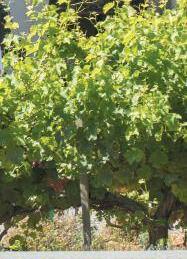







www.ediblemontereybay.com 15
Photo by Patrice Ward
Miso-roasted Carrot Hummus with Furikake and Raw Vegetables

While the kitchen is adding salads, entrées and desserts to its shared and small plates, Ahn stops short of calling it a restaurant. “e food is meant to be an enhancement to the wine, and the experience is wine education based,” Ahn explains. “We will offer meal-sized dishes, but it’s not a sit-down restaurant.”
Weekends find chef Danny plating new offerings on his test kitchen menu. Eventually they will source ingredients from an on-site garden. Garden guru Kai Harper, who came to Folktale from Esalen, has a test plot where he’s growing tomatoes, basil, carrots and radishes.
Fully committed to sustainable farming practices, the gardens and 5-acre vineyard at the winery are cultivated organically. Owl boxes and raptor perches naturally manage pest populations of ground squirrels and gophers. In addition to the vineyard in Carmel Valley, Folktale has vineyards in the Arroyo Seco and Santa Lucia Highlands AVAs.
Visitors are treated to a wine experience that transcends a traditional tasting. e glasses, mouth-blown Austrian Gabriel-Glas leadfree crystal, have a broad bowl and narrowing top. Form follows function and the elegant glass is designed for every varietal and style of wine from Chardonnay to brandy.



“Choose Your Own Adventure,” reads the wine club menu. “We educate. We interact. Our philosophy is for you to enjoy the experience,” says wine educator Kelly Zimmerman. Staff members offer tasting flights of six wines each, pouring two glasses at a time and inviting guests to linger and ask questions. ey encourage the thrill of discovery, the joy of gathering, and they believe that every bottle of wine holds a story. e story continues to develop as community members add threads to the colorful tapestry that is Folktale.
Camilla M. Mann is a food writer, photographer, adventurer and passionate cook. She blogs at www.culinary-adventures-with-cam.blogspot.com and lives in Seaside.
Folktale Winery





8940 Carmel Valley Road, Carmel www.folktalewinery.com

16 edible MONTEREY BAYFALL 2017
Fully committed to sustainable farming practices, the gardens and 5-acre vineyard at the winery are cultivated organically.
Above: Photo by Patrice Ward; left: Photo by Camilla M. Mann
STEAK AND FOLKTALE WINE






Folktale’s latest project is Seventh & Dolores in Carmel, which opened in July with chef Todd Fisher at the helm, amplifying the great American steakhouse with his signature flair. Like all steakhouses, everything is big—big portions, big flavors, big menu and a robust cocktail program to match.
“Like at Folktale, we want guests to experience the thrill of discovering dishes and the joy of gathering together,” says owner Greg Ahn. “What can we do tableside? How do we tell stories about our food?”
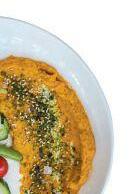
Fisher sources meats from Bay Area-based Niman Ranch, a consortium of family-run farms committed to raising livestock sustainably and humanely. While the full steak experience has diners picking cuts, sauces, dressings and sides, choices are not completely carnivorous. Fisher offers salads and vegetable sides. For seafood lovers, selections include clams casino, crab cakes and a riff on fried calamari with blackened padrón peppers, charred lemon vinaigrette and aioli.
Every dish is colorful, elegant and plated like a work of art. 7D, as the restaurant is known, balances the festive nature of a steakhouse with intimacy and a sense of community. Future plans include a mezzanine addition and menu expansion to include breakfast and lunch.
—CM
Seventh & Dolores
Carmel • 831.293.7600 • www.7dsteakhouse.com

www.ediblemontereybay.com 17
Photo by Camilla M. Mann

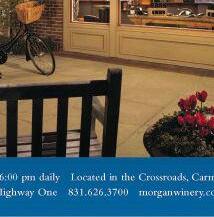

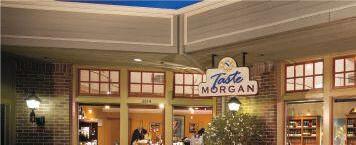

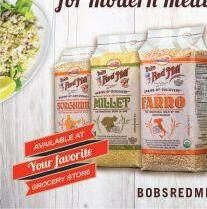

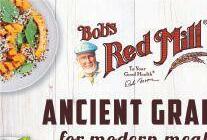


18 edible MONTEREY BAYFALL 2017
WHAT’S IN SEASON WINTER SQUASH AND PUMPKINS
Discover some delicious new variations on these fall favorites
BY DEBORAH MADISON PHOTOGRAPHY BY CRYSTAL BIRNS AND LAURIE SMITH ILLUSTRATIONS BY NIKA CASSARO
Winter squash and pumpkins are among the prettiest mainstays of our fall and winter kitchen. It’s not so many years ago that few people knew much more than the acorn squash, jack o’ lanterns and chunks of banana squash. But new varieties have been filling our market bins, offering us a much wider choice when it comes to size, flavor, shape, texture and taste. ere are hundreds of named members of the Cucurbita family, which includes not only squash and pumpkins, but also summer squash and gourds. Amy Goldman has written the definitive book on the topic called e Compleat Squash: A Passionate Grower’s Guide to Pumpkins, Squashes, and Gourds. It is lavish with illustration and wisdom both and a must read for anyone interested in knowing more about this splendid and varied family.
As I write, local tomatoes, peppers and eggplants are still in their peak season, but with shorter days our tastes may be ready to turn towards these stalwart citizens of the vegetable world. Because of their hard skins we tend to think that winter squash will last forever, but they don’t. I find that by February they’re starting to dry up inside and any bruises incurred earlier are beginning to spread. So go ahead and start enjoying them now.
With the exception of pumpkins grown specifically for eating, squash generally makes a better vegetable than a pumpkin—richer, sweeter, and smoother.
Acorn: is is one winter squash most Americans know—acorn shaped with smooth skin that’s dark green, orange or a splashy mixture of the two. e flesh is paler than most and the flavor can be bland, which may be one rea-
son it’s often sweetened. I have to admit it is not my favorite, although I am told that some new varieties are really quite good. Amy Goldman singles out elma Sanders (also known as elma Sanders Sweet Potato), saying that it’s the sweetest of the acorn group, and tastes somewhat like chestnut.
Sibley: A member of the banana squash group, one used to find these large oblong behemoths cut into slabs and wrapped in plastic at the supermarket. Whole, they’re much too huge for most people to store, cook or even carry. But once cut, it’s an easy squash to work with. Sibley is a striking heirloom with grey-green skin and pale orange flesh; it is considered the best of the banana group.
is buff-skinned squash contains








Not only does it have exceptionally easy to peel, which makes it ideal for smooth fla-
Butternut: is buff-skinned squash has a long, straight, solid neck and a round bottom that contains the seeds. Not only does it have exceptionally good flavor, butternut squash is also easy to peel, which makes it ideal for gratins and other dishes. Use the neck in a gratin, then steam the bottom separately—whole or quartered—and enjoy it as a warm vegetable side dish. An excellent all-purpose winter squash, because it’s so good, it often replaces others, especially heirlooms that are harder to grow and costlier, which is unfortunate. I advise that you force yourself, if need be, to try some less familiar specimens should you come across inexpensive ones.
Violina di Rugosa: is is an Italian heirloom variety in the butternut group that looks like a gigantic Mr. Peanut but tastes unbeliev-

www.ediblemontereybay.com 19
Photo this page by Laurie Smith
ably good. It is rich, sweet, and smooth-fleshed. Not many people grow it, so if you see one, don’t hesitate to give it a try.

like its picture! Not so good to steam (it becomes watery) but delicious roasted or sliced and fried in olive oil or butter.
Mini-Squash and Pumpkins: Tiny varieties like Sweet Dumpling, Jack Be Little and others can be stuffed, baked or steamed. One squash is perfect for one person, especially a child who will love having his or her own baby pumpkin. ey’re cute, convenient and quite good to eat, too.
to





















Buttercup: Different varieties—including Perfection, Honey Delight, Black Forest, Red Kuri and the Japanese Kabocha—are squat and round and usually dark green except for the Kuri, which is red-orange with slightly dry but flavorful, smooth flesh. All of these varieties have dense flesh, which is so extraordinarily sweet, you’ll be asked if you added sugar to your soups. Although the shape suggests fillings of broth and cream, these squash are not particularly good for that purpose since the flesh readily drinks up all liquids. Using them in soup is usually a better option.
Spaghetti Squash: Oval, yellow skinned with pale yellow flesh, this squash is so coarse that its cooked flesh can be pulled into long strands resembling spaghetti. It’s somewhat bland, but good treated just as spaghetti, with sauces. Chilled cooked squash can be tossed with vinaigrette and served as a winter salad. Be sure to puncture it before baking whole to avoid messy explosions in your oven.
Delicata: Cream colored with green stripes, oblong and slender or short and stubby, these small one-pound (or smaller) squash have excellent flavor. eir size makes them good shallow containers, and although their skins are easy to peel, they can also be cooked with the skins on. is squash is closely related to zucchini and other summer squash that we do eat with the skins on. So try leaving the skins on; they will soften and are quite edible.
coarse that its cooked flesh can be pulled into long
Hubbards: Orange, blue skinned, or slate colored, large, ungainly and sometimes covered with warts, this old-fashioned squash is nonetheless one of the best for eating. Fortunately new varieties, such as Queensland Blue, are small enough for the home cook to handle. Good texture and flavor.
new varieties, such as Queensland Blue, are small enough for the home cook to handle. plump, and covered with crusty peanut-like looked

Galeuse d’Eysines: I was drawn to grow this variety because it’s one of those odd-looking cucurbits that is round, plump, and covered with crusty peanut-like bits. It was thrilling when it actually looked
Turban Squash: not and risotto, squash and hefty for their size. e heavier they are, the denser and more moist the flesh. ere may be rough patches on the skins, but the only real problem is soft, spongy spots; avoid
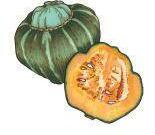
Turban Squash: With their high striped “hats” these look very exotic, but are not nearly as pleasant to eat as to look at. Better for decorations and doorstops.
Marina di Chioggia: is is one of my favorite heirlooms. It’s warty, covered with bluegreen bubbles and oh so good. is is the squash to use for pumpkin ravioli, but it’s also a delicious, silky-textured vegetable to use in a soup, risotto, purée, etc.
Regardless of the variety, squash and pumpkins should be firm and hefty for their size. e heavier they are, the denser and more moist the flesh. ere may be rough patches on the skins, but the only real problem is soft, spongy spots; avoid them if you can, or cut them out if you can’t.

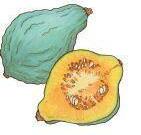
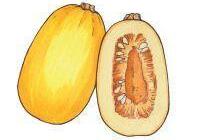
20 edible MONTEREY BAYFALL 2017
How to Store: Cut squash should be wrapped and refrigerated up to a few days, but keep whole squash in a cool, dry place that has plenty of ventilation—a back porch would be ideal. If you like to keep them out where they can be seen, try to use them before they dry out. You can tell when that happens because they become increasingly light.
How to Use: Winter squash are easy to bake, roast or steam. ey can be made into purées and soups and used in pies, breads and cakes. Slices and chunks can be fried, sautéed or baked in gratins and simmered in stews. e skins and seeds are effective in soup stocks, even if they’ve been roasted first.



Special Handling: Cutting large squash can be difficult. A heavy knife or cleaver and a rubber mallet are useful tools. Whack the knife into the squash, then bear down or tap it with the mallet to open the squash. Cut next to the stem rather than through it—it’ll be easier on your knife. Or bake a recalcitrant vegetable whole in the oven until it begins to soften, then cut it into smaller pieces. Some nonchalant cooks I know drop large squash on the floor to break them open—advisable only when all else fails. And it’s a good idea to put it in a bag first.
Yield: Allowing for the seeds and skins, a one-pound squash, halved and baked, is adequate for two servings, and one pound of peeled, seeded squash yields approximately two cups puréed. Whole weights and trimmed weights vary from one squash variety to another, so it’s difficult to give absolute quantities. However, those who love squash will wish for large portions, and leftover cooked squash is always easy to reheat or use in other dishes.
UC Santa Cruz graduate Deborah Madison is the founding chef of Greens restaurant in San Francisco and the author of 14 cookbooks, including Local Flavors, Vegetable Literacy and e New Vegetarian Cooking for Everyone, as well as innumerable articles on food, cooking, farms and gardens. In My Kitchen, her most recent book and admittedly one of her favorites, contains a lot of narrative backstory to old and new favorite recipes and is filled with gorgeous photographs. A Master Gardener, Deborah lives in the village of Galisteo, New Mexico, with her husband, artist Patrick McFarlin, where she writes and attempts to grow her own food and flowers. Aside from attending UC Santa Cruz, her connections to the Monterey Bay area include serving as tenzo, or head cook, at Tassajara Zen Mountain Center in Carmel Valley in the 1970s.

GOOD FLAVORS TO USE WITH WINTER SQUASH AND PUMPKINS


•olive oil, butter, brown butter, ghee
•sage, rosemary, garlic, red pepper flakes, chile molido •brown sugar, coconut milk, ginger, lime, lemongrass, curry spices
•Fontina, Gruyère, Pecorino Romano, Parmesan, blue cheeses •onions, radicchio, apples, pears, quince
www.ediblemontereybay.com 21
BUTTERNUT SQUASH FARROTTO
Courtesy Kenny Woods, chef, 1440 Multiversity in Scotts Valley Serves 4 to 6

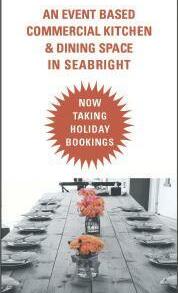

Kenny Woods is living his dream as executive chef at the new, luxuriously rustic-chic 1440 Multiversity in Scotts Valley. e 27-year-old Tucson native supervises the Kitchen Table dining facility on campus, using a seasonal vegetable-driven approach to make sure that conference-goers are nourished in body and mind. He’s excited about a teaching kitchen and garden currently under construction, for classes on diet and nutrition. And he says feel free to experiment with other types of winter squash in making his recipes below.
1 butternut squash
4 cups vegetable stock
1½ cups farro (stay away from instant if you can)
1 tablespoon olive oil ½ cup shallots, minced 2 tablespoons garlic, minced 2 sprigs of thyme, leaves plucked and minced
Preheat the oven to 400° F.
¼ cup white wine
1 3 cup raw cashews, soaked for 1 hour
1 tablespoon yellow miso 1 tablespoon nutritional yeast
1¼ cups water, divided Sea salt and ground black pepper, to taste Pomegranate seeds, for garnish (optional)
Cut the butternut squash lengthwise. Discard seeds and lay both halves, skin side up, on a sheet tray. Roast until tender, about 40 minutes to 1 hour.
In a medium saucepan, combine the vegetable stock and 1 cup of the water and place it over medium heat. Cover the stock and let it simmer. Keep warm.
With 1½ cups of cooked butternut squash from the cooked halves, combine the squash, drained cashews, miso, nutritional yeast, salt, pepper and remaining water in a blender. Blend until silky smooth.
Heat the olive oil in a large pot over medium heat. Add the shallots and cook, stirring frequently, until translucent. Add the garlic and thyme and stir. Pour the farro into the pot and stir.
Toast the farro for around 2 minutes, stirring frequently. Deglaze the pot with white wine, add ¼ cup of water and stir until the liquid is evaporated.
Using a soup ladle, pour hot vegetable stock into farro, one ladle at a time. is will open the starch in the farro and thicken the farrotto. Continue to stir while adding the hot stock. If you use instant farro, you will need less stock.
Transfer the butternut purée to the farrotto pot and incorporate. Season with salt and pepper. Bring the farrotto to a simmer, uncovered for another 5–10 minutes. Continue to stir to avoid sticking to the bottom of the pot. e farrotto is ready when the grains are just past al dente and risotto is not runny.
Garnish with pomegranate seeds, olive oil and black pepper. Goes great with pan-seared fish or poultry.
22 edible MONTEREY BAYFALL 2017
BUTTERNUT SQUASH CRÈME
BRÛLÉE
Courtesy Kenny Woods, chef, 1440 Multiversity in Scotts Valley


Serves 4 to 6
1⁄3 cup organic granulated sugar
6 egg yolks
1½ cups coconut cream
½ teaspoon ground ginger
½ teaspoon ground cinnamon
¼ teaspoon fresh nutmeg
1 tablespoon organic orange zest
1 teaspoon vanilla paste
1 tablespoon olive oil ¼ cup water

1 teaspoon sea salt
¾ cup roasted squash purée

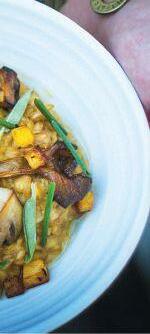

4–6 mini, 3-ounce Mason jars (at’s what we use at 1440)
3 tablespoons organic granulated sugar (for top of crème brûlée)
1 torch for burning crème brûlée top

Cut one large butternut squash in half, remove seeds and coat squash with olive oil. Season with salt and roast skin side up in a 325° F oven for 1 hour. When the flesh is soft, remove from the oven and bring squash to room temperature. Scoop squash out and put into a bar blender. Purée with water until the texture is silky smooth. Set aside ¾ of a cup for recipe.
Cream the egg yolks and 1/3 cup sugar until pale yellow and sugar has dissolved, just before ribbon stage.
Combine coconut cream, orange zest and spices in a saucepan and heat on medium to just before it begins to simmer. Remove from heat and whisk in the vanilla paste and squash purée. en whisk in the egg yolk mixture, whisking until smooth. For even smoother texture, blend base with a stick blender.
Pour the mixture through a fine mesh strainer. Portion evenly into Mason jars or ramekins. Bake in a 350° F oven for 30–40 minutes. ey are ready when no liquid appears after you lightly shake the jars. Remove from the oven and allow to cool.
Sprinkle ½ teaspoon of sugar on top of each custard. Using a small butane torch, hover a flame over the sugar, moving it around until the sugar caramelizes.
www.ediblemontereybay.com 23
Not just any kitchen table: bottom, chef Kenny Woods, at Kitchen Table, the dining room at the new 1440 Multiversity retreat center in Scotts Valley, and top, his Butternut Squash Farrotto
Photos by Crystal Birns
LOCAL FOODS IN SEASON


September, October And November




Fruits: Apples • Asian Pears • Avocados • Blackberries** Cactus Pears Dates • Feijoas**** • Figs • Guavas**** • Kiwis • Kumquats • Lemons Limes*** • Mandarins**** • Melons • Nectarines** • Oranges • Peaches* Pears • Persimmons • Plums • Pluots • Pomegranates • Pomelos**** Quince • Raspberries • Strawberries
Nuts: Almonds • Hazelnuts • Pecans • Pistachios • Walnuts
Vegetables: Beans • Beets • Bok Choy* • Broccoli • Brussels Sprouts* Burdock • Cabbages • Carrots • Cauliflower* • Celeriac • Celery Chard • Collards • Corn • Cress • Cucumbers • Dandelions • Eggplants Endive • Fennel Garlic • Herbs • Horseradish • Kale • Leeks • Lettuces Mustard Greens • Okra • Olives • Onions • Orach • Parsnips Peas • Pea Shoots • Peppers • Potatoes • Radishes • Rhubarb • Rutabagas*** Salsify • Scallions • Shallots • Spinach Sprouts • Squash, Summer and Winter • Sunchokes • Sweet Potatoes • Tomatillos • Tomatoes • Turnips * = September only ** = Only through October ***= October and beyond ****= November only
Fish: Abalone • Halibut, Calif. • Lingcod • Rock Cod/Rockfish Sablefish, aka Black Cod • Sanddabs • Sole Sea Bass, White • Spot Prawns • Squid, Market • Tuna, Albacore

Note: Fish species listed are all harvested by local commercial fishermen and rated “good alternatives” or “best choices” for sustainability by the Monterey Bay Aquarium’s Seafood Watch program.
Research assistance by Real Good Fish and Serendipity Farms. For schedule of local farmers’ markets, see opposite, pages 25–26, or go to www.ediblemontereybay.com.
24 edible MONTEREY BAYFALL 2017
Photo by Carole Topalian








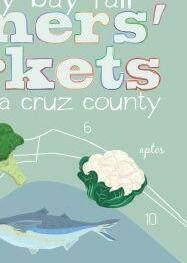













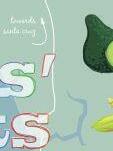











www.ediblemontereybay.com 27








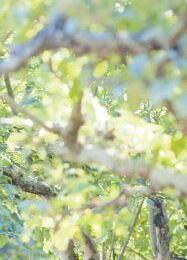

28 edible MONTEREY BAYFALL 2017
Santa
TIME TRAVELERS
Cruz County’s culinary heritage is served up in a tasty new book
BY DEBORAH LUHRMAN PHOTOGRAPHY BY MICHELLE MAGDALENA
Our favorite recipes and dishes often evoke a powerful sense of place. For me, making Pumpkin-Mushroom Soup from Sharon Cadwallader’s Whole Earth Cook Book takes me back to lunches up at the Chadwick Garden on the UC Santa Cruz campus in the 1970s, when she ran the restaurant there; and the Zucchini Burgers we still make every summer from Cynthia Mathew’s 1974 vintage Planned Parenthood’s Zucchini Cookbook transport me to my first garden in the Santa Cruz Mountains, where summer squash grew like crazy.
Capturing a culinary sense of place is the aim of the new book, Harvesting Our Heritage: Bite-Sized Stories from Santa Cruz County History, researched and written over the past five years by four young women who call themselves the heritagistas and call their work “a digestible journey to the past.”

e project started in 2012 when Sierra Ryan—a Santa Cruz County water resources planner—was given a cookbook compiled by her great grandmother, who lived on a farm in the Live Oak neighborhood. “It was gorgeous, all handwritten, like a diary of her food life,” says Ryan, who made copies of some of the recipes and gave them out to friends at Christmas.
ey were inspired to look further, combing through historical archives for more old recipes and the stories behind the foods that people were growing and eating throughout Santa Cruz County’s relatively short history.

“Once you learn what happened before, it puts your own role in Santa Cruz history into perspective,” says Ryan. “It’s not just the here
Enjoying a picnic in Soquel are heritagistas (from left) Jody Biergiel Colclough, Liz Birnbaum, Sierra Ryan and Katie Lang Hansen, along with future heritagistas Iris Colclough (18 months) and Ellery Hansen (3 years old).
and now. It’s part of the past, present and future of local food.”
Ryan was joined by Jody Biergiel Colclough, Liz Birnbaum and Katie Lang Hansen to produce the 131-page book, which recounts the stories of 11 local foods and beverages from the mid1800s to the present.
For example, while the Sierra Foothills were experiencing the Gold Rush, Santa Cruz was enjoying the “spud rush” as farmers hurried to plant potatoes on the fertile banks of the San Lorenzo River. Later they jumped on the bandwagon of different crops, the sugar beet, followed by apples, Brussels sprouts and, eventually, the berries that are planted all over south county today.
“e thing that really struck me in doing this project is that there’s always been that innovative and entrepreneurial culture here,” says Lang Hansen. “It’s not just in surfing or in high tech; we’ve been innovating in food here for 150 years.”
Lang Hansen—a dietician and member of Slow Food Santa Cruz—wrote the chapter on berries, explaining that electricity first arrived in Watsonville thanks to early plantings of strawberries that required lots of water. A flume was devised to bring in water from the mountains and a water wheel was installed alongside the flume to generate power.
e authors, all in their early 30s, were amazed to learn that Santa Cruz was once known as a place to dig for clams and enjoy a clambake on the beach. Clamming for Pismo clams was a really big part of Santa Cruz culture for the better part of 100 years, but sadly ended in the 1970s due to a combination of over-consumption and the resurgence of the sea otter population—clams are one of their favorite foods.
Another chapter examines the more modern history of the dryfarmed tomato, specifically ones grown at Molino Creek Farm north of Davenport. “Dry-farmed tomatoes for me were really emblematic of what’s happening now in Santa Cruz food culture, this incredible cel-
www.ediblemontereybay.com 29
EDIBLE HEIRLOOMS
ebration of ecological organic farming and growing food for taste, not travel,” says Biergiel Colclough, an organic certifier at CCOF.
As part of the research, she interviewed Molino Creek partner and local organic pioneer Mark Lipson, who revealed how the Grateful Dead had played a role in popularizing the farm’s dry-farmed tomatoes. e Dead enjoyed them so much that their chef had them shipped to each one of their tour stops in the late1980s.
e book contains a sprinkling of recipes to accompany each story and try at home, but for the most part they serve as a reminder of how much more sophisticated our tastes have become over time. Nonetheless, the recipes are a start towards defining the true flavor of Santa Cruz.



One of the authors, Liz Birnbaum, plans to bring the stories and recipes in the book to life with a series of themed dinners this fall, put on by her company e Curated Feast.

“rough this project I’ve gotten a sense of place that I didn’t expect,” says Birnbaum. “Now when I drive around and see Chanticleer Avenue, for example, I know it means rooster and refers to the chickens that used to be raised around there. It’s such a beautiful way to access history and one I’m excited to share with people.”
Harvesting Our Heritage will be on sale starting Sept. 1 at the Santa Cruz Museum of Art & History, publisher and advisor on the book, as well as at Bookshop Santa Cruz, selected gift shops, and online through Amazon, with all proceeds going to the museum.

Deborah Luhrman is deputy editor of Edible Monterey Bay and editor of our weekly newsletter. A lifelong journalist, she has reported from around the globe, but now prefers covering our flourishing local food scene and growing her own vegetables in the Santa Cruz Mountains.
EXPLORE: To learn more about the Food Heritage Project and upcoming events related to the book launch, visit the heritagistas’ website www.scheritagefood.wordpress.com. To find out about upcoming history-themed dinners, see www.thecuratedfeast.org.
30 edible MONTEREY BAYFALL 2017
While the Sierra Foothills were experiencing the Gold Rush, Santa Cruz was enjoying the “spud rush.”
TOMATO APPLE CHUTNEY




is recipe is from Libbie Gilmour (Jane Elizabeth Gilmour, married name Pettit), the great-grandmother of Sierra Ryan. She kept a handwritten recipe book, which she started in 1908. She brought it with her when she moved to Santa Cruz with her husband and two small daughters in 1919, and continued to use it for the rest of her life. It is filled with the names of friends, neighbors and family members who gave her recipes that she added to her book over the years.
3 pounds cooked apples (see notes below)
½ pound sliced tomatoes (about 1 cup)
¼ pound chopped onion (about ½ cup)

½ pound raisins (about 1 cup)
¾ pound sugar (about 123 cups)
2 ounces ground ginger (about ¼ cup, see notes below)
Dash cayenne
3 ounces salt (about 1⁄3 cup)
2 cups vinegar
Moisten with vinegar. Cook slowly and covered for 6 hours in oven or 4 hours over slow heat. Stir often.

HERITAGISTAS’
NOTE: We decided that the ground ginger means chopped fresh ginger. We used 3 pounds of apples, then cooked them, so the total was under 3 pounds cooked. We think some of the measurements are off and used 5 tablespoons salt and 5 tablespoons fresh ginger. We used apple cider vinegar.
www.ediblemontereybay.com 31
EDIBLE COMMUNITY




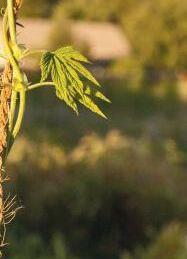
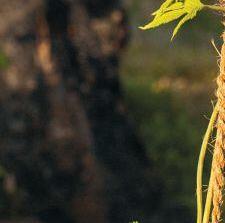




WATSONVILLE AWAKENING
BY ELIZABETH HODGES PHOTOGRAPHY BY JULIE FINEMAN, MICHELLE MAGDALENA, MICHAEL SANTAELLA AND PATRICK TREGENZA
32 edible MONTEREY BAYFALL 2017
Are hipster food and drink businesses making it the Brooklyn of the Monterey Bay?
As a resident of the 95076 zip code, I’ve noticed some changes taking place lately. ere’s an obvious hip factor emerging in what I’ve known as a predominantly working-class community. Young people and families are moving to Watsonville from surrounding areas to save money on rent, to buy homes and farms, and to start businesses. New artisanal food producers, eateries, cafes, wineries and craft breweries are popping up—and thriving. e question bears asking: Is Watsonville becoming the Brooklyn of the Monterey Bay?

While small-scale food and drink businesses are currently trending in Watsonville, the Pajaro Valley has a rich edible history that includes boom times with whiskey, apples, strawberries and the latest cash crop— raspberries. e earliest brewery in Santa Cruz County was the Pajaro Brewery, established in 1860. And Martinelli’s—which opened a new storefront in Watsonville last year—got its start in the Pajaro Valley back in 1868, when Stephen G. Martinelli made fermented sparkling cider with apples from California’s first commercial apple orchards.
But new food and beverage businesses are bursting onto the scene: My Mom’s Mole, e Green Waffle, Hidden Fortress Coffee, Corralitos Brewing and Elkhorn Slough Brewing, to name a few. And this prompts the comparison to other highly fertile and exciting food artisan hubs popping up outside more expensive and larger cities around the country, Brooklyn being the most prominent.
And next to the Watsonville airport an exciting new food and drink complex called e Hangar is taking shape. It includes a taproom run by the folks behind Beer irty in Soquel inside a restored World War II era warehouse, a cluster of six shipping containers converted into eateries and an outdoor seating area with fire pits.
While tenants were still being lined up at press time, developer Brian Dueck said the urban-styled Hangar complex would include a coffee shop, juice bar and, hopefully, other artisanal businesses such as
a bakery, ice cream maker and vegetarian food stall. He plans to open in the first quarter of 2018.
Watsonville’s new food businesses share a similar ethos—family recipes, cultural heritage, healthy convenience food and local, organic produce—and many can be traced back to El Pajaro Kitchen Incubator, established by El Pajaro Community Development Corp. in 2013.
IN THE KITCHEN

El Pajaro Kitchen is filled with the sticky-sweet aroma of strawberry jam the first time I visit. At one of the 15 stations in the vast kitchen space, jam is being made from donated local, organic strawberries for the annual Watsonville Strawberry Festival. At another station, El Nopalito Produce is packing freshly trimmed and peeled nopales Teresa’s Gourmet Foods is making salsa around the corner.
“Energy is booming here. ere’s a lot of heart and there’s a vibrant movement in terms of wanting to change what Watsonville is,” says Cesario Ruiz, who manages the 8,000-square-foot commercial kitchen and also uses it to make his own sauces called My Mom’s Mole.
Executive director Carmen Herrera says small food businesses like My Mom’s Mole and Kitchen Witch Bone Broth (a former client) underscore a renewed interest in old family traditions, remedies and recipes—a reclamation and rebranding of local foods.
“I don’t want to take credit for things that are much bigger than us,” says Herrera, “but I think that programs like the kitchen help to brand Watsonville as a very interesting community, avant garde in many ways.”
She also points out that Watsonville’s location gives clients close proximity to local, organic produce and makes the kitchen central to the Monterey Bay area. Lakeside Organic Gardens is less than two miles


www.ediblemontereybay.com 33
Puckering up at Corralitos Brewing’s hops picking party
Opposite: Photo by Michelle Magdalena; is page: Photo by Michael Santaella




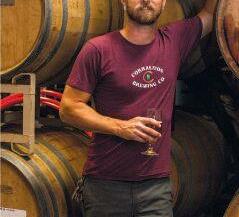



34 edible MONTEREY BAYFALL 2017
Clockwise from top left: Kathryn Lukas of Farmhouse Culture, Luke Taylor of Corralitos Brewing, Cesario Ruiz of My Mom’s Mole, and Amelia Loftus of Hidden Fortress Coffee Roasting
Top, left: Photo by Julie Fineman; Top, right: Photo by Michelle Magdalena; Bottom, right: Photo by Patrice Ward; Bottom, left: Photo by Patrick Tregenza
down the road. El Pajaro Kitchen has had 40 clients since opening. New applications are constantly pouring in.




IN THE COMMUNITY
My Mom’s Mole’s Ruiz has been targeting the Watsonville market for his sauces this year, working with other local businesses like Elkhorn Slough Brewing and doing pop-ups throughout the county. He’s also branching out and applying to events in the Bay Area, such as the Eat Real Festival in Oakland.
“Sometimes it feels like a lot, but looking at the bigger picture, this is what I wanted to do. I wanted to share my mom’s mole with the rest of the world.”
My Mom’s Mole will also be serving at the annual benefit dinner for Food What?! on Sunday, September 17. Food What?! is a nonprofit organization inspiring low-income and struggling teenaged youth across Santa Cruz country through meaningful work and healthy food. Ruiz sits on the board of directors.

Another food artisan at El Pajaro Kitchen is e Green Waffle, owned by Martin and Blanca Madriz. ey created their signature green grab-and-go waffle because they were looking for healthy and convenient foods that they could eat and share with their three children. Blanca, who was born and raised in Watsonville, teaches math and science at E.A. Hall Middle School and knows that mornings can get quite hectic for parents.
Both Blanca and Martin had gotten into physical fitness and Blanca started making protein pancakes for herself that contained pro-
tein powders and artificial ingredients. en she thought, “Why am I eating this if I wouldn’t feed it to my kids?”
ey saw the need for real, healthy and convenient food products that were made without artificial ingredients. After about a year of trial and error, they arrived at the current recipe, which somehow manages to create just the right combination of crunch, tenderness and flavor with just oats, egg whites, spinach, bananas and either yams, cauliflower, blueberries or apples. eir kids, family and friends all approved.
Blanca and Martin love being in Watsonville and sourcing their ingredients locally. “It’s just great to be here, surrounded with all these food sources,” says Martin, who also speaks to kids at E.A. Middle School about how to start their own businesses.
While their product is flying off the shelves in the Santa Cruz area, the Madrizes see the need for more education in terms of nutrition in Watsonville. eir goal is to give back to their community and show people that eating healthy can be fun, creative and convenient. “We want the community to see our presence here, try new foods and think of their health and future.”
en there are people like Amelia Loftus—owner of Hidden Fortress Coffee Roasting—who already have an established business but utilize the consulting aspect of El Pajaro Kitchen. Although she didn’t need kitchen space, she was able to get help with crowdfunding so that Hidden Fortress could get its doors open.
Loftus started roasting coffee while she was with the now-defunct Seven Bridges Cooperative, which she helped found and run for 15
www.ediblemontereybay.com 35
years. Before opening her shop on Hangar Way, she roasted in small batches at her micro-farm, using solar power and propane, and did farmers’ markets and made deliveries in conjunction with a CSA egg program.
e mission of Hidden Fortress is to support the hard-working farmers who grow coffee. Loftus and her husband Patrick both have farming backgrounds. Amelia has roots in a Vermont commune—her childhood story is told in the book We Are As Gods: Back to the Land in the 1970s on the Quest for a New America. Patrick is straight from the west side of Santa Cruz, back when it was still farmland.
“I’ve found Watsonville to be a really supportive environment,” Loftus says. “When we first started building the café, I got a call from Kurt Overmeyer (the city’s former economic development manager) saying ‘Welcome, we’re so glad to have you.’ And it was really nice to receive that.”
FIELD TO FORK
While at first glance farm-to-table is a relatively new concept in Watsonville, the family-owned Gizdich Ranch has been getting people out into the field and all touchy-feely with their fruit for quite some time now. Second-generation farmers Vincent and Nita Gizdich were the masterminds behind opening the farm to the public with a “pik-yorself” berry field. Vince Gizdich, the current (third generation) owner, recalls that the neighboring farmers turned their nose up at this nontraditionalist idea.
But it wasn’t such a bad idea, because nearly a century later, people are still going there to pick their own fruit and buy pie. Gizdich points out an interesting fact: 7 out of 10 visitors who go out to the farm have a connection with a farm in their past. Visiting the farm certainly brought back my childhood memories of traipsing around upick berry farms with my mom and siblings (never mind that I put more berries in my mouth than in the basket).
You can also find Gizdich pies at California Grill, Lakeside Organic Gardens’ farm-to-table eatery, founded by owner Dick Peixoto and his daughter Ashley. Lakeside Organics is the largest family-owned and operated organic vegetable grower-shipper in the country. e restaurant, now located on Green Valley Road, was established in 2012 and features Lakeside’s organic produce, alongside locally processed meats, and local baked goods and wines.
Ella’s at the Airport, a bit newer on the scene, was founded with the same commitment to fresh, local food. Owner Ella King saw the importance of staying rooted in Watsonville—she loved meeting her farmers and being in the fields, doing things like pulling fresh kohlrabi out of the ground. “Our community is what makes us who we are,” she said at last year’s Event Watsonville, held at El Pajaro Kitchen.
Perhaps the hippest Santa Cruz County food business, fresh sauerkraut maker Farmhouse Culture, moved its facilities from the Old Sash Mill to the middle of a Lakeside Organic Gardens field in 2015. Founder Kathryn Lukas says it was a choice between Pajaro Valley and Oakland, but what made the decision clear was the proximity to the source of their cabbage.



She says, “We need to be in the fields, developing relationships with the people who grow our food.”

36 edible MONTEREY BAYFALL 2017












Lukas found the property—a production facility and farmhouse in the middle of 19 organic acres—and fell in love with it. Peixoto also saw the value in it and purchased the property with the understanding that Farmhouse Culture would become the tenant. e companies collaborated to do extensive renovations before the move, and Lukas has turned the old farmhouse into an innovation lab. Farmhouse Culture now sources much of its produce from within six miles of its facilities.
“Looking out of my window, where I work every day, I really see Steinbeck country—the area is so rich in food history and there is real potential for a food cultural hub,” says Lukas.
FIELD TO GLASS
One of the local wineries featured at both California Grill and Ella’s at the Airport is Alfaro Family Vineyards. Owned by Richard Alfaro and his wife Mary Kay, this Corralitos gem was founded in 1997, when the couple bought an old 75-acre apple farm and began transforming the property into a vineyard. From just six acres, their vineyards have now grown to 56 acres, with more vines being planted this year.
Before that, the Alfaros owned a local wholesale bakery called Alfaro’s Micro Bakery, which operated from 1991 to 1998 out of the same building that El Pajaro Kitchen now inhabits. e central location was perfect for making deliveries throughout the Monterey Bay area as well as up to San Francisco, and Alfaro recalls that business was good.
But wine had been a lifelong passion and he had planted some vines in Corralitos. As Alfaro points out, fermentation science is the

same, whether you’re working with bread or wine. “e hobby just got out of control,” he explains, and the family business thus transitioned from bakery to winery.
According to Alfaro, El Pajaro Kitchen couldn’t have a better spot than in the center of an organic farming community that provides all the right ingredients to work with. He’s also happy that more young people are starting small food businesses in the region.



More wineries and breweries are popping up around the area as well, including Wargin Wines, Freedom Wineworks, Corralitos Brewing Co. and Elkhorn Slough Brewing, adding to local veterans Storrs Winery, Windy Oaks Estate Vineyards and Winery, Nicholson Vineyards, Pleasant Valley Vineyards, River Run Vineyards and Alfaro.
Meantime, these artisans are finding themselves with a growing number of home-grown Watsonville-based food and drink events to participate in, such as those hosted by Annie Glass, Live Earth Farm and Corralitos Open Farm Tours, to name just a few.
“We’re just so grateful to be a part of the community,” Alfaro says. “We love Watsonville.”

Taking a moment to savor my green waffle with strawberry jam, I couldn’t agree more. e up-and-coming Brooklyn of the Monterey Bay? I’ll take it. And while there are challenges to overcome, the community is coming together to meet them with conviction, determination and true entrepreneurial spirit.
Elizabeth Hodges is a freelance writer and owner of Verdant California, based in south Santa Cruz County. During her free time, she enjoys keeping chickens, gardening and connecting with the local food community as communications chair for Slow Food Santa Cruz.
38 edible MONTEREY BAYFALL 2017
Hand-processed: Vicente Quintana of El Nopalito Produce and his employees remove thorns from nopales pads at the El Pajaro incubator.
Photo by Patrick Tregenza










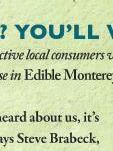

ON THE FARM FORGOTTEN FRUIT
Heirloom apple growers and cider makers breathe new life into historic crop
BY JAMIE COLLINS PHOTOGRAPHY BY MICHELLE MAGDALENA AND PATRICK TREGENZA
Zea Sonnabend—a longtime organic inspector for CCOF in Santa Cruz and member of the National Organics Standards Board— lives just outside Watsonville. As she drove back and forth to work over the last three decades, she passed an ever-dwindling number of apple orchards.
So perhaps it’s not surprising that when she inherited a small amount of money, the first thing she did was buy a 10-acre orchard. “Watsonville has a long history of apples and it’s dying and seemed worth preserving,” she says.
While saving a traditional local product drove her initial purchase, she says craziness is what keeps her going. “It just feels like what I was meant to do.”
e certified organic orchard, in the Corralitos area, is now called Fruitilicious Farm and includes established Gravenstein, Gala, Red Delicious, Jonagold, Empire and Pippin trees. Although she has a farming background, Sonnabend says she’s learned a lot from the “old timers” and managed to save money by buying up used equipment from apple farmers who were going out of business.
“It all started with one golden yellow apple seedling called a pip,” she explains. “at ended up being known as the Newtown Pippin, which were the first apples to be planted in Watsonville in the 1850s.”
e Newtown Pippin was a tremendous discovery due to its balanced tart to sweet
ratio and a pine-like aroma, which made it excellent for eating fresh, baking into pies and pressing into fresh and fermented cider. e juice from Newtown Pippins is still the basis of Martinelli’s apple cider and has been since the 1880s.
Sonnabend’s eyes sparkle as she leans in and tells the story of England’s Queen Victoria and her love for the yellow-skinned pome.
“omas Jefferson, George Washington and Ben Franklin all grew Newtown Pippins. I can’t remember which one it was, but one of them mailed Queen Victoria the apples as a gift. ey were packed in a barrel with straw to keep them from rotting during the long trip overseas. e queen was so in love with the apples that she declared they could be imported without the tariff that other American goods had. e Newtown Pippin was one of the first commercially grown apples, since 1790, to still be in wide circulation and that is saying something!” Sonnabend says.
Sonnabend and her business partner Terence Welch also tend a six-year-old heirloom apple orchard nearby, where they’ve planted 100 varieties and are waiting patiently to find out how they will produce in the Watsonville area.
Eighty varieties were chosen either because they were trees already existing in California or are culturally significant or have resistance to diseases like apple scab, which are hard for organic growers to control.
Twenty trees are exclusively cider apples from abroad and she doesn’t know how they will produce here.
CALIFORNIA HEIRLOOMS
A member of the California Rare Fruit Growers and avid seed saver, Sonnabend made sure to propagate what she considers the three most culturally significant heirloom apples discovered in California: Hauer, Skinner’s Seedling and Sierra Beauty.
e Hauer apple was named after Peter Hauer, who found it growing alongside Pleasant Valley Road in Aptos in 1890. ought to be the lovechild of a cross between a Cox Orange Pippin and a Yellow Bellflower tree, it is squatty and not much to look at, but the flavor is clove-like, spicy and sweet and the flesh white, with thick skin. is late-season “Christmas Apple” as it came to be known, could be stored in straw until spring, but fell out of favor once refrigeration was common.
e Skinner’s Seedling is named after Henry Chapman Skinner, who found it growing in his yard in San Jose. is big yellow/red apple ripens early and is very tart, so it is mainly used for cooking. Its claim to fame is that it needs very little chill time to produce apples, an issue that is coming up now as the climate warms and apple varieties don’t produce as well as they used to in our area.
40 edible MONTEREY BAYFALL 2017
Photo by Michelle Magdalena
She planted with a plan; her kids would be off to college by the time the apples started to produce and she would have time for a new project.


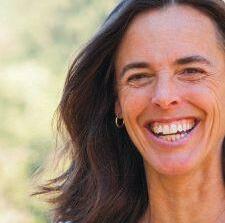




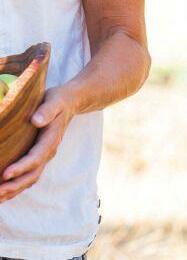


www.ediblemontereybay.com 41
Laura Everett of Everett Family Farm and Soquel Cider







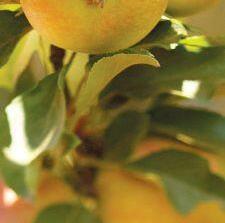



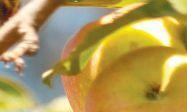








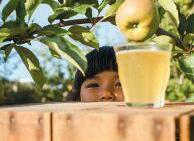
42 edible MONTEREY BAYFALL 2017
“Hard cider makers are requesting the apples be dry farmed and grown organically.”
Photo background of this page by Patrick Tregenza, rest by Michelle Magdalena
e best of the California heirlooms in Sonnabend’s opinion is the Sierra Beauty, a firm boxy apple with reddish stripes and a complex herbaceous and floral flavor, that originated near Chico in the late 1800s and stores incredibly well. Locally it is also known as a Winter Gravenstein and was thought to have been extinct until the 1980s, when it was found growing in Mendocino County in an orchard owned by the Gowan family, farmers who still sell their apples at the Ferry Plaza Farmers’ Market in San Francisco.
I take a bite of one of the farm’s Red Delicious apples and am pleasantly surprised how tasty and crisp they are, and how the color is blush red, unlike the solid red ones I grew up avoiding due to their mushy texture. Sonnabend explains hers are also more flavorful because they are grown on standard rootstock (as all apples planted in the 1800s and early 1900s were, instead of the semidwarf rootstock that is more common today). erefore, they have deep roots and a more complex flavor profile. “Trees on standard rootstock are able to pull more nutrients from the soil and organic apples always taste better because they are receiving compost and natural fertility instead of chemicals,” she adds.
Standard trees are a thing of the past, as they grow very tall and there isn’t skilled apple picking labor in the area any longer. Having inexperienced workers up on tall ladders harvesting 50 pound bags of apples is a liability. ere is also the fact that workers are less likely to want to work in a standard orchard
because the harvest is slower, which means they earn less if they are paid by the pound. Semi-dwarf trees can be picked faster using shorter ladders, however they only live 20 years compared with standard tress, which live as long as a century.


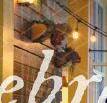

APPLE CITY



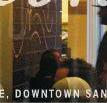

e Pajaro Valley was once at the heart of an apple frenzy. Watsonville was dubbed Apple City and there were one million trees producing on 14,000 acres by 1908.
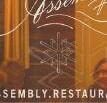

Newtown Pippin and Bellflower were the shining stars of the orchard and fetched the highest prices. Forty packinghouses were built to accommodate the apples, which were shipped out of Moss Landing by boat and through Pajaro, once the train line was completed in the 1870s.

e Apple Annual Association was created in 1909 and attracted tens of thousands of people for a weeklong event called e Apple Show Where Apples Grow. e event was much like a circus, with the focus on apples— under the tents were the latest orchard implements, machinery and inventions, displays of wooden apple harvest bins and the latest and greatest crop production tools. Vaudeville acts performed and participants took part in apple crate making, apple packing and pie eating competitions. e streets were jammed with people and the weeklong event ended with a Mardi Gras-style party, fueled by hard cider and celebration.
Over time, Pajaro Valley apples lost their value as miles of orchards were planted throughout the Pacific Northwest and much of the local landscape has been replanted with more lucrative strawberries and raspberries.
Longtime apple growers like the Prevedelli and Gizdich families have managed to stay in business through the apple decline by finding their own niches. In the 1980s, the Prevedellis began farming organically and selling at local farmers’ markets as a way to make a living from their 80-acre farm in Corralitos, where 35 varieties of apples are grown. Eventually, the family also diversified into berries and row crops such as squash and green beans. Now three generations take part in a dozen farmers’ markets, led by Silvia, the family matriarch and Santa Cruz County farmer of the year in 2016. e Gizdich apple orchards stay in business through a type of agritourism, by hosting u-picks and baking their famous pies.
Others have opted to take advantage of the public’s growing thirst for hard cider. Jake Mann’s great grandfather was one of those farmers who came from Missouri in the 1870s and settled into the apple growing rhythm of Watsonville. Hundreds of acres of apple orchards are still managed today by the Mann family and most fruit is still sold to Martinelli’s for juice.
As a fourth-generation farmer, Mann says there is a lot to learn from his father and he’s still absorbing the knowledge of his ancestors, but he’s also adding his own twist.
www.ediblemontereybay.com 43
While thinning fruit on a Kingston Black cider apple tree, he gave me the lowdown on the history of the farm, explaining how the original Bellflower apples were pruned to form arches so horse-drawn carts could be pulled through the trees without bruising the apples.
Now he is experimenting with “top working” existing Red Delicious trees and grafting on cider varieties like Black Twig instead. “I taught myself how to make cider in order to understand how the apples react during fermentation. at way I can manipulate certain factors for the desired characteristics of hard cider. Hard cider makers are requesting the apples be dry farmed and grown organically, or harvested at certain brix (sugar) content,” he says.
He believes ciders are a noble use of apples. Collecting the fruit, crushing it and tasting the memories is one of his favorite pastimes, along with the weekly apple pies his mom makes during harvest.
FARM TO BOTTLE

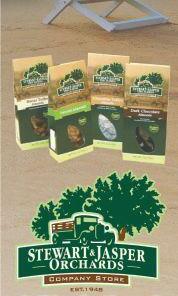

When Rich and Laura Everett bought their Soquel farm in 2000, it came with established Pippin and Gravenstein apples that were historically sent to Martinelli’s. e Everetts started out selling them for juice, but eventually made their own non-alcoholic cider to sell at their farm stand instead.
Four years ago, Laura—who comes from a winemaking family in Napa—decided to try making hard cider. She planted with a plan; her kids would be off to college by the time the apples started to produce and she would have time for a new project. Laura’s energy and passion are off the charts and the cider she makes showcases that drive.
Husband and wife are particular about how they grow their apples, so particular in fact that they have their own separate orchards that they manage completely differently. Rich grows apples he likes for fresh eating like Honey Crisps, which require significant irrigation. He lets the grasses grow tall between the orchard rows and prunes so that the sun hits all of the apples and they can grow big and juicy.
Laura’s cider apple orchard is dry farmed, tidy and the trees are pruned with a central leader—the more natural way apples grow. Since size doesn’t matter for cider apples, there
is little need to thin. Laura’s entire orchard consists of heirloom varieties such as Roxbury Russet, Belle de Boskoop, Yarlington Mill and more.
She dug deep into her memory of college organic chemistry and pored over books to learn as much as she could about the bitter sharps and bittersweet cider profiles. She worked with David Hartzell—friend and home brewer extraordinaire—to come up with some cider she liked, reminiscent of the English style: dry, crisp and not sweet.
Four seasons later, Laura has three ciders available under her Soquel Cider label. e flagship cider is pure Gravensteins; Laura’s Orchard contains a blend of heirloom cider apples only. My favorite of the three is the Barrel Aged, a still cider blend, aged in rye whiskey barrels, that has a depth of flavor and hint of whiskey—which Laura says is best with cheese plates.
Laura is experimenting with capturing the local, wild yeast that grows on the apples in the orchard and has also played around with blends, including farm-grown Greengage plums and Hachiya persimmons in different batches to create spring and fall seasonal ciders. When the tanks can’t hold all the juice that is pressed, she makes apple cider vinegar and plans to offer it in the near future. Everett Farm is the true farm-to-bottle cider maker. “I’m the fermenter, the bottler, the labeler and the marketer!” she says with a laugh. And in tasting the final product, her hard work and dedication show.
As the planet continues to warm and drought and floods become more common, climate will ultimately dictate the crops that can be grown in the Pajaro Valley and elsewhere in the Monterey Bay region. But for now—with the help of these growers and cider makers—local apples have won a reprieve. We hope they will continue to grow and flourish through the years.
Jamie Collins is the owner of Serendipity Farms, which grows organic row crops in Santa Cruz and Monterey counties and distributes them through a CSA, U-picks, farmers’ markets and a virtual farm stand which can be found on Serendipity’s Facebook page.

44 edible MONTEREY BAYFALL 2017


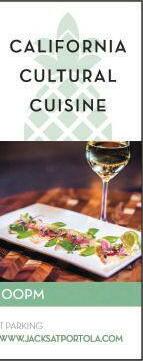








www.ediblemontereybay.com 45
TANUKI CIDER
Cider making takes Robby Honda back to his roots

You could say Robby Honda has apple cider running through his veins. He has fond memories of apple fights with his brother Brad underneath the autumn leaves on his family’s fourth-generation Gravenstein apple orchard in Sebastopol. Robby has wonderful memories of playing between the orchard rows with his little brother, tossing the rotting windfall apples at each other and smelling the sweetness of the apples ripening on the trees.
He was always drawn to the apple orchard and to farming, but his mother discouraged him from choosing farming as a career. To her, apples represented her grandparents’ hardship, trying to piece together a living as Japanese immigrants in America during the early 1900s.
But Honda came to Santa Cruz to get back to his roots and work with apples in 2010, when he started helping out at Fogline Farm and experimenting with fermenting apples on the property. Over the next few years, Robby mastered fermentation and his brother Brad—a graphic artist in the surf industry—created their label, Tanuki. e cider project was one the brothers could work on together.
Honda currently sources from a few special trees at the Five Mile Orchard in Corralitos, including magnificent 30-feet-tall Bellflowers that have beautiful yellow, almost translucent skin with good acid content and brightly flavored juice.
ree ciders have been released so far: Zozois a dry cider made from a 2015 harvest of Newtown Pippin and Mutsu that is unfiltered, unpasteurized and developed in the bottle without the addition of CO2. It is full bodied and mildly carbonated with nuanced farmhouse characteristics and sour notes; Hurricaneis a blend of Newtown Pippin and Mutsu apples from 2015, filtered and fully carbonated in the can. It is crisp, dry and drinks more like cider-style champagne; Pick It Upfrom the 2016 harvest, is a blend of Newtown Pippin, Mutsu, Bellflower and Winter Banana apples. is cider is tart, dry, crisp and fully bottle conditioned with tight, vigorous bubbles.
Home restaurant in Soquel serves Tanuki Cider and chef Brad Briske makes a mindblowing dish using the cider in his black squid-ink spaghetti with Manila clams and pork belly. e sauce is made with chile, miso and Tanuki cider. e use of miso in a pasta dish with cider makes it taste like ramen so many people love it, according to Honda.


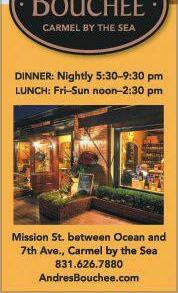
Last year his brother and partner in the cider business passed away unexpectedly. is was a heart-wrenching loss and he first considered stopping the cider project. But soon he realized a need to persevere. “Every bottle I share and every time I talk about the cider, it reminds me of my brother Brad,” says Honda, “and it gives me strength and makes me want to work harder. I think my brother is leading me to success from the other side and helping me to take care of the family through the cider business.”
—JC
46 edible MONTEREY BAYFALL 2017
Photo by Michelle Magdalena
APPLE UPSIDE DOWN GINGERBREAD
Courtesy Zea Sonnabend, co-owner, Fruitilicious Farm Serves 8

is recipe is a favorite of apple grower Zea Sonnabend, who developed it to be grain free. She says the recipe can also be made vegan by substituting oil or coconut butter for the butter and applesauce for the eggs.
Gingerbread: 3 eggs
1 3 cup molasses

¼ cup non-dairy milk of your choice (almond, coconut, rice, hemp)


1 teaspoon pure vanilla extract
6 tablespoons butter, melted
¼ cup maple syrup
1½ cups almond flour
1⁄3 cup coconut flour
1 teaspoon baking soda
¼ teaspoon baking powder

½ teaspoon sea salt
1 teaspoon ground cinnamon
1½ teaspoons ground ginger
1 teaspoon ground nutmeg Pinch of cloves
Apple topping:
4 tablespoons unsalted butter, melted ½ cup light brown sugar
3 Newtown Pippin, Sierra Beauty or other firm apples

For the apple topping, grease sides of an 11x7-inch metal pan. Pour melted unsalted butter into pan. Sprinkle brown sugar evenly over pan bottom. Arrange apple slices, overlapping slightly, on brown sugar mixture.
Preheat oven to 350° F.
Whisk eggs in a small bowl. en add molasses, almond milk, vanilla, butter and maple syrup. Set aside.
In another bowl, combine almond flour, coconut flour, baking soda, baking powder, sea salt, cinnamon, ginger, nutmeg and cloves.
Fold wet ingredients into dry ingredients and mix gently until well combined. Pour batter into pan. Bake for 40–50 minutes or until a knife or toothpick inserted into the loaf comes out clean.
Set pan on wire cake rack and let cool 5 minutes. Serve with ice cream or other suitable toppings.
www.ediblemontereybay.com 47
ROAD TRIP
BY ROSIE PARKER PHOTOGRAPHY BY BEN HALLEY AND ROSIE PARKER
Like most chefs, David Baron understands that he’s nothing without good ingredients. But with a loyal nature and insatiable curiosity, the vendor partnerships he forms go deeper. “It’s about the relationship as much as the product,” he says repeatedly. “If I’m going to work with you, I need to know who you are and what you do. And I want to know why you do it, too.”
I first met Baron in April 2017, shortly after he left Casanova in Carmel and accepted the position of executive chef at Salt Wood Kitchen & Oysterette at Sanctuary Beach Resort in Marina. I was invited to accompany him on a two-day road trip along the Central Coast and into the Central Valley—an epicurean adventure visiting several of his purveyors.


We were joined by Ben Halley (our trusted driver), a chef and hospitality consultant working with Hersha, the parent company of the resort. e journey would end with a feast from our gatherings, cooked by Baron and Halley in the home kitchen of Swank Farms owners, Dick and Bonnie Swank.

Although Baron had worked for years with some of the people we visited, he was meeting others for the first time. Regardless, he had the




48 edible MONTEREY BAYFALL 2017
BACK OF THE HOUSE
Chef David Baron gets to know his farmers and fishermen as he prepares to open his much-anticipated Salt Wood restaurant in Marina
same care, attention, enthusiasm and “you’re in my inner circle” attitude at every stop. Watching Baron listen to everyone’s stories, I was impressed by the powerful relationship and mutual respect between farmer and chef.
“Good food takes hard work,” Baron stressed to each vendor. “at’s the story we want to tell.”




ROASTERS AND RANCHERS


As with any proper road trip, we start with coffee. I meet Baron and Halley at North Coast Roasting, a 100% organic micro-roaster based in Soquel, founded on the belief that what’s good for the planet is good for the people. Baron, a flashy-looking guy with gelled-back hair stands mesmerized by the coffee roasting process. He’s dressed for the road trip in a tight camo thermal, gold chain, baggy cargo pants, and bright yellow Adidas sneakers. Gold-rimmed sunglasses are tucked into his shirt. On first impression it’s clear: David Baron has swagger.
“I’ve never seen this before, not even on TV,” he says with childlike wonder, referring to the satisfying sound and smell of the roasting beans. When the beans are released from the kiln in a cloud of steam, we both
take a comically exaggerated whiff. Baron flashes a giant smile and says, “All I know is we’re about to be hella juiced driving in the car.”
Caffeine seems like the last thing Baron needs. (Side note: Going on a road trip with two chefs, you’re reminded of their superhuman energy and endurance. ey can go for hours without food, water or a bathroom break).
From Soquel, we travel to Merced to meet Cliff Pollard of Cream Co. Meats, a left coast meat distributor based in Oakland. e company is just over a year old, but Baron has been working with Cliff for more than 10 years. “He only works with the best chefs, so I honestly don’t know how I got so lucky,” he says modestly.
Central California is the base for Cream Co.’s Antique Beef program, which focuses on the value of retired Holstein dairy cows, instead of letting the animals get sold to the commodity market. “is is real full animal sustainability,” Baron explains.
“ese are dual-purpose animals,” Pollard adds. “ey have healthy, happy lives on pasture, and, if taken care of, build rich intramuscular fat that produces a delicious meat.”

www.ediblemontereybay.com 49
Going on a road trip with two chefs, you’re reminded of their superhuman energy and endurance. ey can go for hours without food, water or a bathroom break.
Photos by Ben Halley
On the road: opposite, chef David Baron; this page, Baron with the author and some of Baron’s purveyors at Stueve Organic Family Farms
On a tour of Yosemite Valley Beef, the slaughterhouse they use in Merced, I see the awe-inspiring carcasses from the Antique Beef program. Six to eight years old and around 600 pounds, they look like Cadillacs in a garage full of economy cars. “It gets harder for me the older I get,” Pollard admits as we tour the facility. YVB is a certified organic slaughterhouse that averages about 80 kills per day, vastly different than a commodity facility that typically averages 2,800.

“Transparency is the key word for everything we do,” Pollard adds. “That’s why we’re always so excited to get chefs like David out into the field.”


We end the day in Oakdale, visiting Cream Co.’s other Central Valley operation, Full-Tilt Farms. It’s a Demeter-certified biodynamic egg ranch run with Stueve Organic,which raises Cornish Cross chickens on its historic family farm. “Our supply chain is as open as the fields the animals roam on,” says Jake Townsend, who manages the Stueve operations. “So whenever anybody asks, we take them out here.”
FISHERMEN AND FARMERS

e next morning we venture out of the fields and onto the sea. It’s early at the Monterey Wharf and Baron’s mind (and mouth) are already racing. He talks quickly and passionately and at times it’s hard to keep up with him. He punctuates most sentences with: “You know what I mean?”


We meet Adam Aliotti, a spot prawns fisherman who will take us out on his boat, the Ocean Warrior. Aliotti is a fourth-generation Monterey Bay fisherman: “In elementary school I was drawing pictures of commercial boats,” Aliotti says with a laugh. “You can definitely say
it’s in my blood.” His grandfather, Giuseppe (Joe) Aliotti, accidentally founded the fishery in the bay in the 1950s, when spot prawns kept getting caught in his octopus traps. Here only two people hold spot prawn fishing permits, which were handed down generation to generation: Aliotti and one of his cousins.
“I really want to be pushing local seafood at Salt Wood,” Baron explains. “ere will be an iced seafood counter, so I’ll be able to pick up my spot prawns when the season is right and put them on display—raw and alive!”
“When people ask about them, we tell them about Aliotti, because his story is now a part of our story,” Halley adds.
Next we visit Monterey Abaloneand its secret seaweed city that exists right under the wharf. After California banned commercial abalone fishing, owners Trevor Fay and Art Seavey worked hard to sustainably farm red abalone in growing cages suspended under the pier. “It’s an ocean-based operation,” Fay explains. “We’re feeding them their natural diet of kelp and that really comes through in the product.”
It’s surreal underneath the wharf: dark with slippery planks, barking seals, workers suited up in rain bibs and boots, and countless cages of giant kelp. e process for farming abalone is labor intensive and patience testing as it takes at least four years until they reach a harvestable size. “It’s an honor to keep the heritage of our area alive and bring abalone back to the dinner table,” Fay says. “You guys are legends,” Baron confirms. “True legends.”
“Now we’re going to see a different legend,” Baron says with a laugh when we’re back in the car. “We’re going to see my boy!” We’re on our way to Swank Farmsin Hollister where owners Dick and Bon-

50 edible MONTEREY BAYFALL 2017
Photos by Ben Halley
nie Swank have a closeness with Baron akin to family. Swank is goodnatured with a warm smile and strong sense of humor. Baron runs around him like a gnat that Swank has to keep swatting away.
“I started working with Dick three years ago when I started buying tomatoes from him. But that was all he would sell us at that time,” Baron recalls. “You didn’t want anything else!” Swank shouts back. “I tried to get you to buy other things!” Baron gives a knowing smirk and says, “Well, look where we are now! You’re my guy!”
Touring the farm, we stop at various fields so Baron can harvest produce. “He’s such an inspiring chef,” Swank effuses. “He gets out there and really engages—with us, with his family, with the community, with his staff. It was hard to get in the inner circle and we work hard every day to make sure we don’t mess up. But it’s farming, it’s unpredictable—we mess up. So it’s good to know we have David in our corner.”
THE CHEF

Baron, 33, is a first-generation American of Nicaraguan and Filipino descent who grew up in the San Francisco Bay Area. His grandmother on his mother’s side was a tamale lady. “I was a curious kid, always getting in trouble. Travieso—that was my nickname,” he says with a smile—travieso in Spanish translates to naughty. “So the kitchen was where I grew up, because that was the best place to keep an eye on me.”
One of four children, Baron says that dining out was a luxury they couldn’t afford. So he learned the importance of making food from scratch and the power of a home-cooked meal. “My mom taught us how to show compassion for others through food, through the act of sharing food, and small gestures, like bringing the man at the gas station a tamale, or customizing the empanadas to fit all of our likes and dislikes.”
It was when Baron was in high school, going to continuation school and volunteering at St. Anthony’s kitchen and the St. Francis Living Room in the Tenderloin of San Francisco, that he decided he wanted to be a chef. After fulfilling his mother’s request that he attend college, Baron signed up for culinary school and immediately started training.
From the start, Baron built an impressive resumé, with stints in the kitchens of Chris Cosentino at Incanto, Daniel Patterson at Coi and Dominique Crenn at Atelier Crenn. “I’ve been fortunate to work with chefs who make you better because they demand that you work at their level,” he reflects.
In 2014, Baron relocated to Carmel to take the position of executive chef at Casanova. Despite the slower pace of the Monterey Bay area, Baron stayed busy. He has an innate need to interact with his community—whether it’s through his kids’ sports teams (he has three children under the age of five) or by volunteering at local schools. He has been an avid supporter of the MEarth ecoliteracy program in



www.ediblemontereybay.com 51
Carmel and recently purchased a home in Marina, where he’s dedicated to bringing some of those same programs to schoolchildren there.
“Working and living here, I have this incredible opportunity to build this great restaurant, and build great chefs, but I also have the opportunity to build my community,” he says. “I’m motivated to put Marina on the map beyond the restaurant.”
THE DINNER

“So, what’s on the menu?” I ask as we unload our bounty into Bonnie Swank’s remodeled “chef’s dream” home kitchen.
“Oh, I have no idea,” Baron replies nonchalantly. After a pause, he gestures at the spread on the kitchen island—teal- and purple-striped abalones, a pile of translucent orange-red spot prawns (many bursting with roe), biodynamic eggs, marbled tenderloin from the Antique Beef program, a whole organic chicken, deep red dulse, bowls of herbs and edible flowers, bags of roasted whole coffee beans, crates full of Swank Farms produce. “I mean, all of this is what’s on the menu.”

is ingredient-driven approach is indicative of how Baron thinks about the menu at Salt Wood. “We live in a bounty of some of the best produce in the world. at’s so inspiring. My approach is natural. I want the dishes to come together organically. I want to truly highlight the ingredients of our area. And I have to draw on all my training— classic and new-school techniques—to achieve that,” he says.
I settle in with my glass of wine and watch the show—a dance in the kitchen between two chefs laying claim on ingredients. I’m quickly intoxicated by the sweet, salty, smoky smell of brown butter and cauli-


flower, pan-seared chicken, blistered cherry tomatoes, and braised leeks with kale and chard. Beets are buried in whole coffee beans and roasted in the oven. Baron and Swank go outside to build a fire pit. Cherrywood smoke billows up through the grate covered with beef tenderloin, abalones in their shells and spot prawns atop blackened leeks.
Dinner is served. We sit around the table, plates piled high. Reflecting on the bounty, I think about something Halley said after we left the wharf that morning:
“ere’s a push in our industry right now to shy away from commodity production, to seek out heirloom, endemic species and bring them into the limelight. Otherwise, they will disappear. It’s up to David and other chefs in this region to really pioneer that again—seek out these vendors, get their products onto the dinner table and make people understand that they should support these local endeavors.
“It’s about supporting my network of people, supporting my community,” Baron had told me early on. “It’s about being in a position to potentially change your community’s outlook on food. I don’t take that lightly.”



For the first time in two days he is quiet. Sated, sleepy, a can of beer in his hand, Baron looks content. “It’s going to be fun,” he says repeatedly about opening Salt Wood. I can’t imagine he would have it be any other way.
Rosie Parker, a native New Englander, likes to complain of missing home while living the Santa Cruz high life—surfing, hiking, writing and working for a delicious craft brewery.
52 edible MONTEREY BAYFALL 2017
My mom taught us how to show compassion for others through food, through the act of sharing food.
Photos by Rosie Parker
In the kitchen: Baron with Bonnie and Dick Swank










www.ediblemontereybay.com 53
BY JORDAN CHAMPAGNE PHOTOGRAPHY BY MICHELLE MAGDALENA









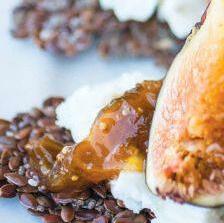
54 edible MONTEREY BAY FALL 2017
PRESERVATIONIST GIVING TREE Savor autumn’s luscious bounty of figs year-round
THE
For 10 years I taught jam workshops at a historic Victorian home in Oakland. In the yard lived the oldest surviving barn in Oakland and a fig tree that appeared older than the barn.

at fig tree was a serious conversation piece. With its bark and trunk so uniquely shaped with bumps and curves, it looked almost scarred. e bare branches of the winter and the dense shade of the spring and summer all made this tree look gigantic. When gathered in the backyard, people often asked, “What kind of tree is that?”
And then when they found out they would ask, “What can you do with figs?” No one asked about the lemon tree next to it; it was always that fig.

It is no surprise that the tree and the fruit are filled with so much intrigue. Cultivated since ancient times, figs grow in the very hot, dry climates of the Middle East and Asia. is makes them perfectly poised for featuring in all sorts of religious texts and ancient lore, which means that humans have a long history of being intrigued by figs and their trees and foliage. e fig leaf is found all over the Louvre museum in Paris as one of the first body coverings. It is almost as if it is bred into our DNA to be intrigued by the fig. But isn’t it odd that something so ancient is still so unfamiliar and remains a mystery?
What do you do with figs? You would think that since figs were some of the earliest cultivated fruits we would know what to do with them. e fig holds an allure of the ancient and can actually put us in touch with a very distant past.
I grew up in Chicago where the only fig that I had ever tasted was a dried one. Figs, like many other delicious fruits, do not ship well and do not last long after harvest. is makes fresh figs a real treat to be enjoyed near where they grow. California is a perfect climate for many varieties of figs, which produce both in the spring and in the fall. e larger crop is in the fall, the perfect time for making fig jam.
at tree in the backyard in Oakland was the first time I ever picked a fig right from the tree and ate it fresh. e best figs are when they are hot from the sun and squishy between the fingers. Biting into a fresh, warm fig in the sunshine can make one feel that they are actually in a Renaissance painting. Fig trees produce so much fruit that if you have one or know of someone with one, then making fig jam is a must! I have taken a liking to making small batches of fig jam, harvesting the fruit fresh from the tree. Unlock the mystery of figs and make jam!
Jordan Champagne is the co-owner and founder of Happy Girl Kitchen Co. She has a passion for preserving the local, organic harvest and loves sharing her secrets at workshops she teaches in Pacific Grove and in Oakland.
FIG JAM
Courtesy Jordan Champagne, proprietor, Happy Girl Kitchen Co. in Pacific Grove
Yields four 4-ounce jars
I have to admit that I was not that interested in making fig jam for a long time. e ones I had tasted were too thick and sweet. I preferred to eat dried, minimally processed figs. I finally became determined to make a fig jam with less sugar and a more spreadable texture that I would enjoy.
A visual delight, figs look gorgeous on the tree and in a bowl on the table. ere is just something about them that makes them one of the sexiest fruits on the planet. e good news is that they are very easy to work with and turn into a fabulous low sugar jam. Low maintenance and sexy—the perfect combination! You can use any variety of figs for this jam, but be sure they have great flavor. I added cardamom and orange zest to play off of the origins of the fig tree in the Middle East.
2 pounds figs (approximately 2 baskets) ¾ cup organic sugar ¼ cup lemon juice 1 teaspoon powdered cardamom 1 teaspoon ginger, freshly grated Zest of 1 orange
Day 1: Wash and dry the figs. Cut off the stem of the figs and cut into quarters. Place figs in the bottom of a small pot. Drizzle with the lemon juice and sugar and let sit overnight or up to three days in the refrigerator. is process of letting the fruit soak in the sugar and lemon juice is called maceration. It helps the fruit release its juices. e natural pectin of the fruit intermingles with the sugar, and the chemistry begins. is also helps decrease the cooking time later so that your jam will taste fresher!
Day 2: Peel and grate the ginger and zest the orange with a microplane. Add the powdered cardamom, ginger and orange zest to the pot with the figs in it. Notice how much juice has been pulled out of the figs overnight. To cook down the jam you should use a pot with a heavy bottom and the heat source should be solid and strong. You want to start cooking down your jam over a heavy flame and stir as it comes to a boil. Since this jam is such a small batch, it will cook down very quickly. I have often made this batch size while preparing dinner and it only takes about 10 minutes to cook down. The figs gel really nicely once the fruit and the juice come together. I do not even do a gel test with fig jam, as it is visually obvious when it comes together into a jam. Enjoy with a sharp, salty cheese and some homemade bread.
www.ediblemontereybay.com 55
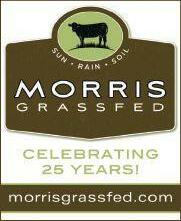

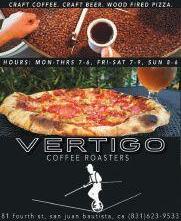






56 edible MONTEREY BAY FALL 2017 MONTEREY BAY MARKETPLACE • MONTEREY BAY MARKETPLACE
Dine Local GUIDE



Carried Away
APTOS
7564 Soquel Drive • 831.685.3926 www.carriedawayfoods.com

A cozy, green-certified, take-out or eat-in café, Carried Away has a menu that changes weekly and features primarily organic, locally sourced ingredients. Owner/chef Tom McNary worked for many years at Chez Panisse, and his dishes reflect the seasons. Soups, salads, entrées and desserts are all made freshly daily. in-crust pizzas available on Tuesday, Friday and Saturday. Open M–F 11am–7pm, Sa 11am–5pm, Su closed.
BIG SUR
Sierra Mar at Post Ranch Inn
47900 Highway 1 • 831.667.2800


www.postranchinn.com

Executive chef Elizabeth Murray and executive pastry chef Ben Spungin use exceptional ingredients, many grown on site, to deliver a unique gastronomic take on the Big Sur experience. Dinner features a 4-course prix fixe menu and the 9-course Taste of Big Sur tasting menu; lunch offers 3-course and 5-course options. Choose from almost 3,000 different wines from the Wine Spectator Grand Award winning wine list. Arrive before sunset for breathtaking views from this iconic restaurant’s floor-to-ceiling windows and cliff-side terrace. Open daily for lunch 12:15–2:30pm, dinner 5:30–9pm.
CAPITOLA
East End Gastropub

1501 41st Avenue • 831.475.8010
www.eastendgastropub.com
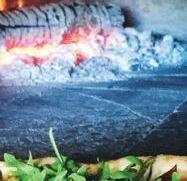
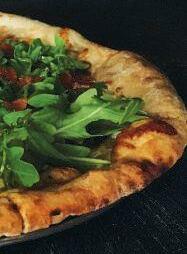
East End Gastropub is the newer baby sister to the popular West End Tap & Kitchen, but aside from sharing owners and chefs, East End’s beautiful, recently renovated modern interior is entirely different from West End and offers its own robust, sophisticated, beerfriendly menu. Chef Geoffrey Hargrave has created dishes that are familiar yet innovative, such as the cacio e pepe farrotto with charred radicchio or the quinoa crusted Fijian albacore. e restaurant also offers its own brews, along with local rotating taps and a strong wine list. Open daily 11:30am–9:30pm.
e Penny Ice Creamery
820 41st Avenue • 831.204.2523
www.thepennyicecreamery.com
Open Su– noon–9pm, F–Sa noon–10pm
See e Penny description under Santa Cruz for more.
Shadowbrook
1750 Wharf Road • 831.475.1511
www.shadowbrook-capitola.com
A Santa Cruz County landmark since 1947, the worldfamous Shadowbrook continues to be an overwhelming favorite with locals and visitors alike. Its fine food, extensive wine list and unparalleled setting and ambiance have earned it numerous awards, including Northern California’s “Most Romantic Restaurant” and “Best Date Night Restaurant.” Gift cards and reservations available online. Open M–F 5–8:45pm, Sa 4:30–9:45pm, Su 4:30–8:45pm.

www.ediblemontereybay.com 57
of these restaurants emphasize local ingredients, and they also advertise in Edible Monterey Bay! Stop by for a free issue, and tell them that we sent you!
All
Above: VERTIGO COFFEE ROASTERS in San Juan Bautista uses a wood-fired oven on its back patio to bake its wonderful wood-fired pizzas. For more, see p. 64.
CARMEL
Andre’s Bouchée

Mission Street between Ocean and Seventh avenues 831.626.7880 • www.andresbouchee.com
Chef Benoit Petel utilizes the bounty of the Monterey Bay with the best seasonal ingredients in the classic and creative French cuisine he prepares at this warm and elegant restaurant in downtown Carmel. Standouts include Monterey abalone with gnocchi, wild mushrooms and seaweed; escargot with garlic parsley butter, hazelnuts and puff pastry; and a classic duck confit with lentils. Petel works with the Monterey County farmers’ markets and other local sources to obtain the freshest ingredients. Open for lunch F–Su noon–2pm and nightly for dinner 5:30–9:30pm. Wine tasting F–Sa noon–4pm. Wine hour menu served at the bar daily 5:30–7pm.
Aubergine
Monte Verde Street at Seventh Avenue • 831.624.8578 www.auberginecarmel.com
Located within the romantic L’Auberge Carmel, a visit to Aubergine feels like a trip to Europe. Executive chef Justin Cogley was named one of Food & Wine’s best new chefs of 2013. He has been nominated multiple times for a James Beard award and it’s no wonder—he’s an eloquent and imaginative interpreter of fine seasonal ingredients. Executive pastry chef Yulanda Santos delights with stunning and inventive desserts. Open daily 6–9:30pm.
Cantinetta Luca


Dolores Street between Ocean and Seventh Avenue 831.625.6500 • www.cantinettaluca.com

Prepared in the Tuscan tradition, using the freshest and simplest ingredients sourced locally or imported from Italy, this authentic Italian eatery serves housemade breads, pastas and sauces, hand-cut premium meats and antipasti with the restaurant’s artisanal salume. Guests are served in an atmosphere of warm tones and dark woods, which invites lingering over a second glass of wine or another bite of tiramisu, apple crostata or cheese. Dinner Su– 5–9pm, F–Sa 5–10pm; Lunch F–Su noon–3pm.
Covey Breakfast Restaurant, Bar & Deck 8000 Valley Greens Drive 831.620.8910 • www.quaillodge.com



Overlooking the pond and manicured grounds, the newly remodeled Covey Breakfast Restaurant, Bar & Deck includes motorcycles from the Moto Talbott Museum in Carmel Valley in a nod to Quail’s annual motorsports event. Chef Brian Kearns has created two new menus with nourishing skillets, eggs benedict and huevos rancheros for breakfast and light-hearted dishes for the evening hours, such as fried chicken and waffles, duck fat fries and his signature Bubbles and Birds—buttermilk fried chicken with a glass of Perrier Jouët Champagne. Open daily 6:30–11am, W–Su 5–10pm.
Earthbound Farm’s Farm Stand

Organic Kitchen
7250 Carmel Valley Road • 831.625.6219 www.ebfarm.com/ourstory
At its Carmel Valley Farm Stand, Earthbound Farm’s certified organic kitchen delights with housemade soups, sandwiches, baked goods and an expanded salad bar. Experience picturesque Carmel Valley as you stroll through Earthbound’s organic gardens and learn about its pioneering local heritage and commitment to organic

58 edible MONTEREY BAY FALL 2017
integrity. Food is available for takeaway or a relaxing afternoon at tables in the gardens. Groceries also are available for replenishing your pantry. Watch Facebook for special events and classes! Open M–Sa 8am–6:30pm, Su 9am–5pm.
Edgar’s at Quail

8000 Valley Greens Drive 831.620.8910 • www.quaillodge.com

Taste the fresh ingredients harvested from local organic farms that are hand selected by Edgar’s executive chef Brian Kearns and exquisitely prepared by his culinary team into the savory dishes available on its new menus. Set in the clubhouse of Quail Lodge & Golf Club, Edgar’s restaurant and bar features a casual elegance with its indoor and outdoor fireside dining located alongside the natural backdrop of the golf course and Santa Lucia Mountains. Edgar’s at Quail is proudly guided in the principles of sustainability by the Monterey Bay Aquarium Seafood Watch and focuses on local farm-to-table options. Open daily 11am–9pm.
Il Grillo

Mission Street between Fourth and Fifth avenues 831.238.9608 • www.ilgrillocarmel.com

e intent behind this sister restaurant to Carmel’s popular La Balena is to create a more casual spot where diners can gather for a glass of wine, simple pastas and small plates. Enjoy a housemade Italian cookie or dessert after your meal, or put in an order to bring some treats home. Prices are also lower than at La Balena, but the same chef is creating the dishes, so expect impeccable sourcing and delicious results. Garden seating available. Open M–F 11:30am–9pm, Sa 5–9pm.
La Balena

Junipero Street between Fifth and Sixth avenues 831.250.6295 • www.labalenacarmel.com
Winner of EMB’s 2014 Local Heroes award for Best Chef/Best Restaurant, La Balena has a seasonal menu that changes daily but always expresses an inventive take on the rustic food of a Tuscan trattoria. e outstanding culinary team sources ingredients from local organic farms and prepares the restaurant’s pastas and slowcooked meats from scratch daily. Owners Anna and Emanuele Bartolini have created an excellent Italian wine list and a warm, inviting atmosphere, complete with back garden seating. Open Tu–Su 5–10pm.
CARMEL VALLEY

Lucia Restaurant & Bar

Bernardus Lodge & Spa • 415 W. Carmel Valley Road 831.658.3400 • www.bernarduslodge.com/wine-cuisine

Indulge in artisanal California country cuisine, awardwinning wines and an expansive heated outdoor terrace with the finest views of all Carmel Valley restaurants at Lucia Restaurant & Bar. Named for the Santa Lucia mountain range and wine appellation that beckons to the south, renowned chef Cal Stamenov serves both his signature tasting menu and dishes à la carte. Wine list is equally notable. A private chef’s table and wine cellar also are available. Enjoy live music Monday and Tuesday evenings, Saturday and Sunday for brunch. Open daily 7am–2:30pm and 5–10pm.

www.ediblemontereybay.com 59
Trailside
Café and Beer Garden
3 Del Fino Place • 831.298.7453
www.trailsidecafecv.com


ose needing to refuel after a day on the trail can head to Trailside Café for home-cooked meals in Carmel Valley. Beer lovers get to choose from 16 on tap, and sports fans can watch games on the HDTVs. Locals are treated to specials on Mondays and Tuesdays. On the weekends enjoy live music in the beer garden. Check out the calendar on its website for more details. Dog friendly in outdoor areas. Open daily 8am–9pm.
DAVENPORT
Whale City Bakery

490 Highway 1 • 831.423.9009 www.whalecitybakery.com Davenport’s artistic charm and oceanside location make it hard not to slow when you pass through on Highway 1. ose in the know always stop at the historic Whale City Bakery. e bakery tempts with housemade breads, pastries, muffins and pies—and that’s only the beginning! Whale City also offers a full restaurant that serves up comfort classics and other hearty dishes. e bar and live music every ursday attract a loyal local following. Open daily 6:30am–8pm.

FELTON
e Cremer House

6256 Highway 9 • 831.335.3976 www.cremerhouse.com


Housed in the oldest building in Felton, e Cremer House showcases progressive, made-from-scratch food and drinks with a nod to its historic mountain surroundings. is alehouse has filled a niche in the San Lorenzo Valley, bringing to this restored and revered property craft beer, cider and wine on tap, and combining it with organic and sustainable fare made with local ingredients. Open Tu–, Su 11:30am–9pm, F–Sa 11:30am–9:30pm.
MONTEREY
e Club Room
2 Portola Plaza 831.649.2698 www.portolahotel.com/dining/the-club-room e Club Room offers a fresh, seasonal, buffet featuring made-to-order omelets, assorted housemade pastries and muffins, sliced cold cuts, fine artisan cheeses, bottomless mimosas and much more. Dine in the cozy fireside dining room, or breathe in the fresh coastal air on the outdoor, pet-friendly, heated patio. Open for breakfast daily 6–11am.
e C restaurant + bar

InterContinental e Clement Monterey 750 Cannery Row • 831.375.4500 www.ictheclementmonterey.com
Step into the C restaurant + bar, and the bustle of Cannery Row will seem like a world away. Elegant yet relaxed, the C offers stunning ocean views from its floor-to-ceiling windows and oceanside deck; Executive Chef Matt Bolton provides equally gorgeous food, imaginatively prepared from sustainably sourced seafood, meats and produce. Creative cocktails include a design-your-own Bloody Mary, as well as sparkling wine flights from around the world. Open daily 6:30am–10pm, Happy Hour 4–7pm Su–. Live Music F–Su noon–3pm, –Sa 6–9pm.
60 edible MONTEREY BAY FALL 2017
Jacks Monterey
2 Portola Plaza
831.649.7830 • www.jacksatportola.com



Jacks Monterey offers “California Cultural Cuisine” and seats guests beneath the trees in a glass-topped atrium where they can enjoy the sun by day and the stars at night. Reflecting the palette of the Monterey Peninsula, the new space is decorated with ocean blues, driftwood browns and the greens of coastal flora. Chef Danny Abbruzzese’s new seasonal menu provides a melting pot of flavor profiles from the entire California coastline and other exotic locales. Open for lunch daily 11:30am–4pm; dinner daily 4–11pm.
Peter B’s Brewpub
2 Portola Plaza 831.649.2699 • www.peterbsbrewpub.com



Experience Monterey’s original craft brewery, Peter B’s Brewpub, located behind the Portola Hotel & Spa. Enjoy great food and award-winning handcrafted beers. Watch your favorite game on one of 18 HDTVs or enjoy the pet-friendly heated patio with fire pits. Peter B’s is open daily with nightly Happy Hour from 4–6:30pm. Open Su 11am–11pm, M– 4–11pm, F 4pm–12am, Sa 11am–12am.
e Poke Lab

475 Alvarado Street info@thepokelab.com • www.thepokelab.com
Serving fresh, light and sophisticated casual dining made from local, sustainable ingredients, e Poke Lab has revamped the Monterey lunch scene. ree signature bowls include two with a variety of fresh tuna and salmon and one vegetarian option. Build the rest of your sizable creations with a choice of rice or salad and varied toppings and sauces. Sushi burritos are also available; order online for quickest pick-up. An official Seafood Watch partner restaurant, e Poke Lab only serves seafood rated sustainable. Open M–Sa 11am–8pm. Follow Instagram (@ePokeLab) for weekly food truck locations. Inquire about catering.
Schooners Coastal Kitchen & Bar 400 Cannery Row • 831.372.2628 www.schoonersmonterey.com Sit out on the oceanside patio if you can, but it’s still considered seaside dining if you are seated inside the dining room, whose polished wood, bay windows and seafaring décor seem like the interior of a sailing ship. Schooners Coastal Kitchen & Bar serves sustainable seafood and prime steaks. e restaurant takes a creative Californian approach to soups, fresh salads, sandwiches and wood-fired flatbreads, paired with a diverse wine list featuring local favorites. Open daily 6:30am–11pm.
Stone Creek Kitchen 465 Canyon del Rey Boulevard • 831.393.1042 www.stonecreekkitchen.com
A glass-walled kitchen in the middle of a spacious cookware and tabletop shop turns out imaginative Mediterranean deli treats and sweets to take away or eat under the market umbrellas outside. Sandwiches, salads and entrée options change seasonally. Don’t miss Paella Fridays! Cooking classes, tasting events and dinner parties are hosted in the intimate teaching kitchen. Find a schedule of upcoming events on the website. Open M–F 10am–7pm, Sa 10am–4pm, Su closed.

www.ediblemontereybay.com 61
TusCA Ristorante

Hyatt Regency Monterey Hotel & Spa

1 Old Golf Course Road • 831.657.6675 www.hyattregencymonterey.com


Blending the beauty and bounty of Tuscany and California, and inspired by the hearty appetite and abundance of southern Italy, TusCA serves up seasonally sourced menus made from fresh, local produce, meats and fish. TusCA chef Steve Johnson delights diners with meals both intriguing and indulgent, particularly those baked in his wood-burning oven or served with the housemade pastas. Open daily for breakfast and lunch 6:30am–2pm, dinner 5:30–9pm Tu–Sa.
e Wharf Marketplace

290 Figueroa Street at Wharf No. 2 and Del Monte Avenue 831.649.1116 • www.thewharfmarketplace.com e Wharf Marketplace is Monterey’s newly remodeled, go-to, fresh, local market with free 24-minute parking. It features the best-grown Salinas Valley lettuces and vegetables, artisanal cheeses, wines and draft beer. e Café & Grab-n-Go selections are designed to satisfy your cravings for every meal. Catering made easy for any staff breakfast or lunch and ready-to-take home dinners are sure to delight. Comfortable indoor/outdoor seating is available. Open daily M–Sa 9am–7pm, Su 9am–6pm; Taste It ursdays offer complimentary wine and beer tasting with one-bite wonders 4:30–6:30pm.
MOSS LANDING
e Haute Enchilada
7902 Moss Landing Road • 831.633.5843 www.hauteenchilada.com
Gourmet Latin fusion dishes await those who venture off Highway 1 and into this fanciful restaurant with its large gallery out back that also serves as a venue for entertainment and private events. Fiesta-colored walls in the restaurant are adorned with enormous gold leaf paintings. Try dishes like Peruvian Ceviche, Squash Blossom Empanadas or the popular Pescado Cubano— line-caught red snapper in a pistachio/pumpernickel crust served with tomatillo avocado sauce. Ingredients are all natural, organic as much as possible. Open daily 11am. Last seating at 8pm.
PACIFIC GROVE
Happy Girl Kitchen Co.

173 Central Avenue • 831.373.4475 www.happygirlkitchen.com


e menu changes daily at Happy Girl’s airy and bright Pacific Grove café, but the food is always delicious, organic and reasonably priced. e sandwich of the day is $6.50, and a bowl of the soup of the day is $6. To drink, you’ll find kombucha on tap and freshly roasted Four Barrel coffee brewed to perfection. Homemade baked goods include a daily scone, cookies and turnovers. Check the website for information on seasonal workshops. Open daily 7:30am–3pm.
Jeninni Kitchen + Wine Bar
542 Lighthouse Avenue • 831.920.2662 www.jeninni.com Inspired by flavors of the Mediterranean, Jeninni Kitchen + Wine Bar’s rich and decadent cuisine takes you on a journey from Morocco and Spain to the Levant, birthplace of owner and sommelier, amin Saleh. Don’t miss chef Matthew Zimny’s crispy octopus, lamb burger with signature eggplant fries and occasional

62 edible MONTEREY BAY FALL 2017
paella nights and other special events. Open every day except Wednesday, Su– 4–9pm, F–Sa 4–10pm. Happy Hour—”sips and snacks”—4–6pm.
Passionfish

701 Lighthouse Avenue • 831.655.3311 www.passionfish.net
If you’re looking for a restaurant with playful, spectacular food and a scrupulous commitment to sustainability, this green-certified restaurant is hard to rival. e elegant dining room is celebratory yet relaxed, and the award-winning wine list features many sustainable names and is priced at retail. Chef Ted Walter’s menu is ever changing with the seasons, but always includes delicious organic local produce, inventive slow-cooked meats and an array of sustainable seafood choices. Open daily 5pm.
Point Pinos Grill



79 Asilomar Boulevard • 831.648.5774 www.ptpinosgrill.com




With sweeping views of the coast and a relaxed clubhouse vibe, this scenic spot has blossomed under the direction of executive chef Dory Ford. For breakfast, choose from huevos rancheros, chicken fried steak and an array of tasty omelets. For lunch through dinner, enjoy dishes like Ale-Steamed Mussels and Crispy Fried Dry Rubbed Jerk Chicken Wings paired with craft beers, local wines or a house specialty cocktail. Open M–F 7:30am–8pm, Sa 7am–8pm, Su 7am–6pm. Happy Hour is M–F 4–6pm.
PEBBLE BEACH
e Bench
e Lodge at Pebble Beach, 1700 17-Mile Drive 866.543.9318 • www.pebblebeach.com/dining
Overlooking the 18th hole at Pebble Beach Golf Links, e Bench at e Lodge at Pebble Beach delivers an eclectic menu inspired by international styles and methods, which uses the innovative technique of wood roasting and open-flame cooking. You can also enjoy one-of-a-kind craft cocktails, as well as an array of draft beers and wines by the glass. Open daily 11am–10pm.
Gallery Cafe
e Lodge at Pebble Beach, 1700 17-Mile Drive 866.543.9318 • www.pebblebeach.com/dining
Overlooking the first tee of Pebble Beach Golf Links, Gallery Cafe offers a wide selection of breakfast choices, from light smoothies to omelets and pancakes. For a casual lunch, try the excellent burgers or choose from a delicious selection of artisan sandwiches, plus the best milkshakes this side of the 1950s. Open daily 6am–2pm.
Pèppoli at Pebble Beach
e Inn at Spanish Bay, 2700 17-Mile Drive 866.543.9318 • www.pebblebeach.com/dining
At Pèppoli, the scents of Italian herbs and spices fill the air, and the décor transports you to a cozy Tuscan villa. e menu is big and bold, ripe with traditional pastas, seafood and meats. e extraordinary wine list is matched by equally impressive dishes, including delicious desserts, all with stunning views of Spanish Bay. Open daily 5:30–10pm.

www.ediblemontereybay.com 63
Roy’s at Pebble Beach

e Inn at Spanish Bay, 2700 17-Mile Drive 866.543.9318 • www.pebblebeach.com/dining
It’s all about big flavors and the gorgeous ocean view at Roy’s at Pebble Beach. Fresh seafood is front and center, where sushi, sashimi and blackened rare Ahi tuna are prepared to perfection, but many exciting meat dishes and island salads are also featured on the extensive Hawaiian-fusion menu. Add a dynamic wine list, exceptional desserts and an energetic environment, and you have one impressive dining experience, all overlooking Spanish Bay. Open daily for breakfast 6:30–11am, lunch 11:30am–5pm, dinner 5:30–10pm.
Stave Wine Cellar at Spanish Bay
e Inn at Spanish Bay, 2700 17-Mile Drive 866.543.9318 • www.pebblebeach.com/dining
A combined wine lounge and retail shop, Stave Wine Cellar is a luxurious yet casual space that is ideal for special wine dinners or gathering with friends and colleagues. You can pair varietals by the glass with a menu of cheese and charcuterie plates. In addition to nearly 30 wines and eight craft beers by the glass, Stave has more than 200 wines for purchase by the bottle, including a wide selection of coveted bottles. A knowledgeable staff, including certified sommeliers are on-hand. Open Tu–Sa 2–10pm, Su–M 2–7pm.
STICKS


e Inn at Spanish Bay, 2700 17-Mile Drive 866.543.9318 • www.pebblebeach.com/dining Open for breakfast, lunch and dinner, Sticks is the perfect place for seasonally diverse California cuisine in a lively sports bar atmosphere. Savor a tasty meal, a cold draft beer, specialty cocktail or one of the many appetizers, while enjoying sports on flat-screen TVs. Outside on the patio, enjoy seating next to a fire pit while soaking up gorgeous views of e Links at Spanish Bay and the Pacific Ocean along with nightly bagpiper music. Ask about specials and new menu additions. Open daily 6am¬–9pm.
Stillwater Bar & Grill



e Lodge at Pebble Beach, 1700 17-Mile Drive 866.543.9318 • www.pebblebeach.com/dining Stillwater Bar & Grill prides itself in offering the freshest and most flavorful in sustainable seafood and organic produce. Whether it’s breakfast, lunch or dinner—or Stillwater’s famous Sunday Brunch—the menus are sure to delight. Shellfish lovers will marvel at the bountiful seafood tank, while those who prefer turf to surf can choose from a variety of meaty options. Each of these delectable feasts is enhanced by fantastic views of Carmel Bay and the 18th hole of Pebble Beach Golf Links. Open daily 7am–10pm.
e Tap Room


e Lodge at Pebble Beach, 1700 17-Mile Drive 866.543.9318 • www.pebblebeach.com/dining
e Tap Room is more than a legendary 19th hole with an outstanding selection of draft and bottled beers, vintage wines and top quality spirits. It’s also a world-class steakhouse serving up hearty all-American fare, from burgers to prime rib to filet mignon. Renowned for its extensive collection of prized golf memorabilia, e Tap Room is a comfortable and inviting place for watching televised sporting events or recounting your successes on the courses of Pebble Beach. Open daily 11–12am.
SAN JUAN BAUTISTA
Vertigo Coffee Roasters 81 Fourth Street • 831.623.9533 www.vertigocoffee.com Artisanal coffee roasted on site as well as local craft beer, wood-fired pizzas, salads, sandwiches, breakfast items plus pan dulce from El Nopal bakery in Hollister have made Vertigo a locals’ favorite as well as a great find for visitors en route to the San Juan Mission, Pinnacles or other area attractions. Open M– 7am–6pm, Fri–Sat 7am–9pm, and Sun 8am-6pm.

SANTA CRUZ
an epicurious lifestyle 104 Bronson Street, Suite 13 831.588.7772 • www.anepicuriouslifestyle.com An event-based commercial kitchen and dining space in a carefully curated warehouse in the historic Seabright Cannery building, an epicurious lifestyle is available for unique private events (book your holiday event now) and hosts a monthly, seasonal family-style dinner for 20 that is open to the public. Monthly dinners this fall will include “A Farmer’s Affair,” an intimate farm-to-table experience highlighting rotating guest farmers and featuring fresh, seasonal produce from each farm. Public events have a limited number of tickets. Check the website for future dates.

64 edible MONTEREY BAY FALL 2017
Assembly
1108 Pacific Avenue • 831.824.6100

www.assembly.restaurant



is full-service restaurant from Penny Ice Creamery founders Kendra Baker and Zach Davis offers rustic California cuisine based on local, seasonal and sustainably sourced ingredients. Watch for new chef Jessica Yarr to make her own mark. e restaurant’s woodmetal-stone décor radiates from a long community table that anchors the center of the dining room, which is filled with natural light in daytime and bathed in the soft glow of copper accents at night. Open for lunch weekdays 11:30am, dinner W–M until late, brunch 10am Sa–Su, closed Tu.
Charlie Hong Kong
1141 Soquel Avenue • 831.426.5664 www.charliehongkong.com
Charlie Hong Kong has been providing the Santa Cruz community with healthy, sustainable, affordable and high-quality food since 1998. e colorful, casual eatery’s delicious fusion of Southeast Asian influences and the Central Coast’s local organic produce has made it an inclusive, family-friendly, neighborhood favorite. Its slogan is “love your body, eat organic,” and its cuisine is proof that fast food can be good for you. All signature dishes are vegan with the option to add meat or fish. Gluten-free modifications available. Open daily 11am–11pm.
e Crow’s Nest 2218 E. Cliff Drive • 831.476.4560 www.crowsnest-santacruz.com

A perfect spot to enjoy lunch or catch a sunset over the harbor, the nautical-themed Crow’s Nest is a Santa Cruz institution that never goes out of style. ere’s always something happening, from free seasonal ursday night beach parties to comedy nights and happy hours. Famous for its salad bar and house-smoked salmon, e Crow’s Nest is a member of Seafood Watch and is a certified green business. Open daily for breakfast 7:30am–11:30am; lunch M–F 11:30am–2:30pm and Sa–Su 11:30am–3pm; dinner M–F 5pm, Sa–Su 4:30pm.
Laílí
101B Cooper Street • 831.423.4545 www.lailirestaurant.com


Exotic flavors of the Silk Road are served in a stylish dining room decorated in eggplant and pistachio colors and on a hidden candlelit patio. Locals rave about Laílí’s homemade naan served warm from the oven with a selection of Mediterranean dips. ere is a wide variety of deliciously spiced vegetable dishes, organic whenever possible, and all meats are hormone free and free range. Open daily for lunch 11:30am–2:30pm, dinner 5–9:30pm.
La Posta
538 Seabright Avenue • 831.457.2782 www.lapostarestaurant.com
A cozy neighborhood bistro not far from the Santa Cruz yacht harbor, La Posta chef Katherine Stern prepares Northern Italian cuisine using local ingredients—some foraged and some grown on nearby organic farms. Charcuterie is house cured; pasta, bread, and gelati are made in-house, while the balance of the menu reflects whatever produce is freshest right now. A sister restaurant of Soif Restaurant and Wine Bar, La Posta also offers a great selection of wines. Open Tu– 5–9pm, F–Sa 5–9:30pm, Su 5–8:30pm, M closed.

www.ediblemontereybay.com 65
Pearl of the Ocean

736 Water Street • 831.457.2350

m.mainstreethub.com/Pearloftheocean Award-winning chef/owner Ayoma Wilen goes beyond the expected traditional spice-infused dishes of Sri Lanka, creating locally inspired daily specials using fresh, organic produce from farmers’ market produce and sustainably harvested seafood. Customer favorites include butternut squash curry, crab curry and wild salmon curry. To round out the flavor experience, there is a dizzying array of sides, like coconut leek sambal and kale mallam. e warm colors, altars and blessings that decorate the space help guests get a sense of Sri Lanka’s world-class hospitality, culture and beauty. Open for lunch daily 11am–2:30pm; dinner Su– 5–9pm and F–Sa 5–9:30pm.
e






Penny Ice Creamery

913 Cedar Street • 831.204.2523 www.thepennyicecreamery.com
Lines out the front door of its converted Spanish bungalow are evidence of Penny’s popularity. All ice cream, including bases, is made from scratch on the premises using local organic ingredients when possible. Dozens of exotic flavors rotate seasonally, but two favorites are bourbon bacon chocolate and strawberry pink peppercorn. Open daily noon–11pm.
Downtown – Kiosk 1520 Pacific Avenue, Suite K2 Open Su– noon–6pm, F–Sa noon–9pm See also e Penny under Capitola.


e Picnic Basket 125 Beach Street • 831.427.9946
www.thepicnicbasketsc.com

Across the street from the main beach, owners of e Penny Ice Creamery have opened an alternative to boardwalk fast food. Sandwiches, organic salads, coffee and beer, all from local food artisans, and of course Penny’s popular ice cream, are all on offer to eat in or outside with your feet in the sand. Open daily 7am–4pm.
Rosie McCann’s 1220 Pacific Avenue • 831.426.9930 www.rosiemccanns.com
No typical Irish pub, Rosie’s emphasizes organic, local ingredients in its traditional Irish dishes like lamb stew, shepherd’s pie, corned beef and cabbage and fish and chips, as well as its California specialties such as grassfed burgers, coriander wild salmon, salads and fish tacos. Expect dozens of beers on tap—including local selections. All desserts are made in house, so save room for the Guinness-Ghirardelli chocolate cake. Open M–F for lunch 11:30am–4pm; dinner 4–10pm. Open Sa–Su for brunch 9:30am–2pm; dinner 2–10pm.
Soif Restaurant and Wine Bar 105 Walnut Avenue 831.423.2020 • www.soifwine.com

Inspired by the offerings from local farmers and provisioners, chef Mark Denham’s cuisine shows California flair, with super, seasonal dishes, all paired with local and exotic wines (and a great burger!). A cozy, new bar offers cocktails in addition to the best wine selection in town. e bottle shop next door provides a world-class selection of winesand a welcoming seating area for sipping and tasting. Raw oysters and live jazz every Monday. Open Su– 5–9pm, F–Sa 5–10pm. Wine bar opens noon Tu–Sa, 5pm Su–M.

66 edible MONTEREY BAY FALL 2017
West End Tap & Kitchen




334D Ingalls Street • 831.471.8115 www.westendtap.com
Perfect for any parent who is looking for a happy hour to satisfy the whole family, at West End adults and kids alike can’t get enough of the duck fat popcorn, fried calamari and flatbread pizzas. A diverse, season-driven menu with offerings like rainbow trout with roasted trumpet mushrooms, and an even longer list of craft beer, cider and wine options make West End a Westside staple. e outdoor patio is perfect for people watching amidst the bustling Swift Street Courtyard. Open daily 11:30am–10pm.
WATSONVILLE
California Grill



40 Penny Lane • 831.722.8052 www.californiagrillrestaurant.com
Using farm-fresh organic produce from Lakeside Organic Gardens and run by Lakeside owner Dick Peixoto’s daughter Ashley, California Grill specializes in hearty farm-style breakfasts, exquisite salads and soups, and a wide variety of entréee choices for dinner, with a full bar. Try the omelets, eggs benedict or chilaquiles for breakfast. For lunch don’t miss the Whole Farm Salad, and for dinner sample Italian-style pastas, ribs or hearthealthy seafood options. Open daily for breakfast and lunch 7am–2:30pm. Open M– for dinner 5–9pm, F–Sa 5–9:30pm, closed Su for dinner.
Gizdich Ranch 55 Peckham Road 831.722.1056 • www.gizdich-ranch.com
Visitors from great distances love this third-generation, family-run farm business that popularized the “pik-yorself” experience just east of Watsonville’s Interlaken neighborhood. Tour the farm, pick fresh apples or berries or watch the action inside the juice-pressing barn. No one leaves hungry if they spend time at the bakery-deli that pleases with its fresh pies, shortcakes and pastries, along with hearty sandwiches and box lunches. is family friendly experience is also a treat for kids, who will enjoy the wide-open spaces and the homemade popsicles. Open daily 9am–5pm.
Hidden Fortress Coffee 125 Hangar Way, Suite 270 831.228.1400 • www.hiddenfortressfarm.com A locals’ market favorite puts down some roots just two minutes off of Highway 1 in Watsonville. Owner Amelia Loftus serves up house-roasted, organic coffee and bagged beans to go, sourced from small-scale family farms in the best coffee-growing regions around the world. is low-key, charming café also sells local and organic baked goods, housemade seasonal smoothies, yogurt parfaits, salads, sandwiches and local chef-prepared soups. Open M–F 6:30am–3:30pm, Sa 9am–3pm. Closed Su.

www.ediblemontereybay.com 67





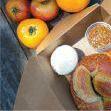





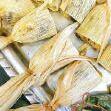






68 edible MONTEREY BAYFALL 2017 Join the conversation and share your discoveries... ...and we’ll share ours with you. Stay connected with Edible Monterey Bay staff, contributors and readers. Subscribe to our e-newsletter online at ediblemontereybay.com and follow us on our social media channels. Edible Monterey Bay @ediblemontereybay @ediblemontbay @ediblemb @pourgirl @liveearthfarm @sleeplessmediadesign @santacruzdahlias @paradisecatering
Edible Monterey Bay Fall 2017 LOCAL SOURCE GUIDE

Find the Monterey Bay’s best local, seasonal and sustainable products and services here. ese business advertise in Edible Monterey Bay, supporting our mission and enabling us to provide this magazine to you for free. Please thank them with your business and tell them we sent you!

APPAREL

Madrigal
Carmel Plaza, Mission between Ocean and 7th, Carmel-by- the-Sea | 831.624.3477

Offering attire for men and women who prefer a classic look.
Pacific Trading Co. 1224 Pacific Ave., Santa Cruz | 831.423.3349 504C Bay Ave., Capitola | 831.476.6109 facebook.com/pages/pacific-trading-co/65027935549
Independent, local, family-owned women’s apparel boutique.
ART GALLERIES & HOUSEWARES


Annieglass 310 Harvest Drive, Watsonville 831.761.2041 x21 | annieglassstore.com
Locally designed and handmade slumped-glass plates, bowls and serving dishes that add famed art and style to the dining room.
R. Blitzer Gallery
2801 Mission St., Santa Cruz 831.458.1217 | rblitzergallery.com Located on the West Side of Santa Cruz featuring monthly shows of regional, national and international fine art.
BANKS AND CREDIT UNIONS

Santa Cruz County Bank 7775 Soquel Drive, Aptos 831.662.6000 | sccountybank.com 819 Bay Ave., Capitola | 831.464.5300
720 Front St., Santa Cruz | 831.457.5000
4604 Scotts Valley Drive, Scotts Valley 831.461.5000
595 Auto Center Drive, Watsonville | 831.761.7600 A leading community business lender and full-service bank of choice for locals.
BREWERIES AND TAPROOMS
East End Gastropub
1501 41st Ave., Santa Cruz 831.475.8010 | eastendgastropub.com
Local gastropub serving handcrafted food, beer and wine.
Peter B’s Brewpub 2 Portola Plaza, Monterey 831.649.4511 | portolahotel.com
Monterey’s first craft brewery features delicious, locally brewed beer and an innovative menu including vegetarian and gluten-free options.
Santa Cruz Mountain Brewing 402 Ingalls St., Ste. 27, Santa Cruz 831.425.4900 | santacruzmountainbrewing.com
An award-winning, certified-organic craft brewery featuring wildly imaginative seasonal beers, hard ciders, draught root beer and kombucha.
Trailside Café and Beer Garden 3 Del Fino Place, Carmel Valley 831.298.7453 | trailsidecafecv.com
Café and beer garden with handcrafted food and a rotating draft selection of 15 beers and one cider plus over 40 bottled selections including Belgian, German and ciders.
West End Tap & Kitchen 334D Ingalls St., Santa Cruz 831.471.8115 | westendtap.com
Local gastropub serving handcrafted food, beer and wine.
CATERING
an epicurious lifestyle 104 Bronson St., Ste. 13, Santa Cruz 831.588.7772 | anepicuriouslifestyle.com
An epicurious lifestyle is an event-based commercial kitchen and dining space in Santa Cruz.
Aqua Terra 529 Central Ave., Pacific Grove 831.657.9790 | aquaterraculinary.com
Fresh and seasonal food ideas, rooted in sustainability.
e Bridge Restoration Ministry 225 Central Ave., Pacific Grove 831.372.2033 | tbrm.org
e Bridge’s culinary program provides culinary vocational skills to its residents to help them restore their lives while providing catering services to the Monterey County community.
Carried Away 7564 Soquel Drive, Aptos 831.685.3926 | carriedawayfoods.com
Seasonally driven and organic prepared foods and catering operating for 25 years in the Aptos Center.
e Poke Lab 475 Alvarado St., Monterey 831.200.3474 | thepokelab.com
Food truck and other catering formats serving fresh, locally sourced poke bowls.
CHEF ASSOCIATIONS
ACF - American Culinary Federation Monterey Bay Chapter P.O. Box 7034, Carmel montereybaychefs.org
A nonprofit association of professional chefs, cooks, bakers, home enthusiasts and business associates in the food service and hospitality industry, this local AFC chapter focuses on continued education and participates in many local community events.
DESIGNERS
Dina Clark Design


831.466.9843 | dinaclarkdesign.com
A Central Coast graphic design studio for logos, labels, illustrations and websites.


EDUCATION AND NON-PROFITS


e Bridge Restoration Ministry
225 Central Ave., Pacific Grove 831.372.2033 | tbrm.org
e Bridge’s culinary program provides culinary vocational skills to its residents to help them restore their lives while providing catering services to the Monterey County community.
Monterey Peninsula Water Management District 5 Harris Court, Bldg. G, Monterey 831.658.5600 | mpwmd.net
Providing and protecting our region’s water supply.
EVENTS

Open Farm Tours
Oct. 8, 2017 | 10am–4pm
Santa Cruz County openfarmtours.com
Connecting food, farms and families.
San Benito Olive Festival Oct. 14, 2017 | 10am–5pm
Brigantino Park 2037 San Juan Road, Hollister 831.537.7270 | sanbenitoolivefestival.com
A gourmet celebration of local agriculture and culinary delights.
FARMS, RANCHES, CSAS AND CFSS
Earthbound Farm
Retail: 7250 Carmel Valley Road, Carmel 831.625.6219 | ebfarm.com
e country’s largest organic grower, Earthbound Farm has been delivering delicious, clean produce to the local community for more than 30 years.
Gizdich Ranch
55 Peckham Road, Watsonville 831.722.1056 | gizdich-ranch.com
A third-generation farm and bakery-café specializing in heirloom apples, berries, juice and pie.
www.ediblemontereybay.com 69
Lakeside Organic Gardens
25 Sakata Lane, Watsonville 831.722.6266 | lakesideorganic.com
Lakeside Organic Gardens, located in Watsonville, is the largest family-owned, solely organic vegetable grower/distributor in the U.S.
Live Earth Farm 831.763.2448 | liveearthfarm.net
Watsonville based, with a new farm stand 10am–3pm on weekends at 1275 Green Valley Road and CSA pickup throughout the Monterey Bay and South Bay regions. Committed to sustainable food through a CSA, farmers’ markets and on-farm farm stand and education.
Monterey Farms 1354 Dayton St., Ste. I, Salinas 831.757.7297 | montereyfarmsartichokes.com Small, locally owned and operated manufacturer of specialty artichoke products.

Morris Grassfed Beef CSM, at markets and online 831.623.2933 | morrisgrassfed.com A provider of locally grown grassfed beef, fostering healthy relationships between people, land, animals and food.
GREEN PRODUCTS AND SERVICES




Blade Tech 831.917.1330 | bladetechusa.com
Professional knife sharpening services for business and home kitchen; also offering high-quality knives and accessories for purchase.
Greenspace 719 Swift St., Ste. 56A, Santa Cruz 831.423.7000 | greenspacecompany.com
Sustainable solutions for interiors, offering zero-VOC paints, organic latex mattresses, organic towels and linens, sustainable flooring and more!
Solar Technologies
705 N. Branciforte Ave., Santa Cruz 831.421.0440 | solartechnologies.com
Local solar energy system provider featuring efficient technology, design and installation for your home or business.
HEALING AND WELLNESS
Acubloom 833 Cass St., Monterey 831.383.9652 | acubloom.com
Healing simply, simply healing with Kristan Roth, a healer with more than 20 years of experience in acupuncture and a number of other modalities.

Woman’s Wellspring

Stephanie Taylor, M.D., Ph.D. 26365 Carmel Rancho Blvd., Ste. F, Carmel 831.622.1995 | womanswellspring.com A new approach to health care based on personal and community wellness.

HOME IMPROVEMENT/REUSE STORES
Habitat for Humanity/ReStore
4230 Gigling Road, Seaside | 831.899.1362 | habitatsc.org 719 Swift St., Santa Cruz | 831.824.4704 | habitatsc.org
A nonprofit home improvement store and donation center offering new and gently used furniture, home accessories, building materials and appliances to the public. Proceeds build affordable homes, community and hope locally.
HOTELS AND RESORTS

L’Auberge Carmel
Monte Verde Street and 7th Avenue, Carmel-by- the-Sea 831.624.8578 | laubergecarmel.com
A romantic, full-service boutique, Relais & Chateau hotel is within walking distance of all that Carmel-bythe-Sea has to offer, including the iconic Carmel Beach.
Bernardus Lodge & Spa
415 W. Carmel Valley Road, Carmel Valley 831.658.3400 | bernarduslodge.com
Located in the heart of sunny Carmel Valley, Bernardus Lodge & Spa is an elegant and intimate luxury resort offering renowned dining and spa experiences and a 10acre on-site estate vineyard.
Hyatt Regency Monterey 1 Old Golf Course Road, Monterey 831.372.1234 | monterey.hyatt.com
Located on Del Monte Golf Course amid 22 beautiful acres of Monterey pines, this hotel also offers a spa and close proximity to Monterey Airport and the city center.
InterContinental e Clement Monterey 750 Cannery Row, Monterey 831.375.4500 | ictheclementmonterey.com e premier luxury hotel in the heart of Cannery Row, situated right next to the Monterey Bay Aquarium and overlooking the pristine Monterey Bay National Marine Sanctuary.
Monterey Plaza Hotel & Spa 400 Cannery Row, Monterey 831.920.6710 | montereyplazahotel.com
At Monterey Plaza Hotel & Spa you’ll be able to enjoy the best of Northern California such as the Monterey Bay Aquarium, historic downtown Monterey and Fisherman’s Wharf, world-class golfing at Pebble Beach, shopping in Carmel, wine tasting in Carmel Valley and the memorable Big Sur coastline.
Pebble Beach Resorts
17-Mile Drive, Pebble Beach 866.935.6341 | pebblebeach.com
Stunning views, legendary golf, diverse and exceptional cuisine and luxury accommodations are all part of the world-renowned Pebble Beach experience.
Portola Hotel & Spa
2 Portola Plaza, Monterey 831.649.4511 | portolahotel.com
A relaxing retreat in historic Monterey surrounded by unique shopping, fine dining, spectacular coastal trails and beaches.
Post Ranch Inn/Sierra Mar Restaurant 47900 Hwy. 1, Big Sur 831.667.2800 | postranchinn.com
A “sanctuary for the soul” offering the ultimate in luxurious coastal Big Sur lodging, including breathtaking views and exquisite dining.
Quail Lodge & Golf Club
8000 Valley Greens Drive, Carmel 831.620.8808 | quaillodge.com
Quail Lodge features comfortable lodging, an 18-hole championship golf course, fitness center and sustainably sourced, seasonal cuisine on the Monterey Peninsula.
MEDIA
90.3 KAZU


100 Campus Center, Building 201, Room 317, Seaside 831.582.5298 I kazu.org
Public radio for the Monterey Bay area.

KZSC
Santa Cruz, 88.1FM 831.459.2811 | kzsc.org
College radio broadcasting from UC Santa Cruz. Tune in for music, news, public affairs, sports, and more!
NATIONAL SUPPORTERS
Castor & Pollux Natural PetWorks castorpolluxpet.com
Makers of ORGANIX, the only complete line of USDA organically certified pet food, and PRISTINE, pet food made with responsibly sourced ingredients.
Bob’s Red Mill
Available at grocers throughout our region and at bobsredmill.com.
Bob’s Red Mill has for decades been a trusted source of stone-ground, non-GMO flours, cereals and baking mixes.
70 edible MONTEREY BAY FALL 2017
NURSERIES, LANDSCAPING AND GARDEN SUPPLIES






DIG Gardens
420 Water St., Santa Cruz 831.466.3444 | diggardensnursery.com
A garden shop unlike any other: organic, bohemian, modern style from Santa Cruz.
Mountain Feed & Farm Supply 9550 Hwy. 9, Ben Lomond 831.336.8876 | mountainfeed.com
Mountain Feed & Farm Supply is a unique and complete organic farm, garden, homestead, pet, gift and housewares store located in the Santa Cruz Mountains.
Plant Landscape Design
2801 S. Main St., Soquel 831.476.1895 | plantlandscapedesign.com
Full-service landscaping company: design, build, maintain, serving greater Monterey Bay.


Terra Nova Ecological Landscaping Santa Cruz | 831.425.3514 | terranovalandscaping.com
A full-service ecological landscaping company providing design, installation and maintenance of beautiful living systems for public and private lands.
REAL ESTATE
Lisa Guthrie/Santa Lucia Preserve
1 Rancho San Carlos Road, Carmel 831.620.6762 | santaluciapreserve.com Lisa@thepreservelife.com
Santa Lucia Preserve is home for 300 families on 20,000 acres of pristine land in Carmel.
RECREATION
Chardonnay Sailing Charters

704 Soquel Ave., Santa Cruz 831.423.1213 | chardonnay.com


Excursions aboard the Chardonnay II are perfect for any age group and fun for everyone from seasoned sailors to first-time adventurers.
RESTAURANTS AND CAFÉS
See our Dine Local Guide, p. 57.
SPECIALTY FOOD AND DRINK PURVEYORS
Earthbound Farm’s Farm Stand and Organic Kitchen
7250 Carmel Valley Road, Carmel 831.625.6219 | ebfarm.com
Serving delicious organic, handcrafted food, gourmet groceries and unique gifts, as well as fresh produce and flowers.
Hidden Fortress Coffee Roasting
125 Hangar Way, Ste. 270, Watsonville 831.228.1400 | hiddenfortresscoffee.com
Small-batch, locally roasted organic coffee sold by the pound.
Lakeside Organic Gardens
25 Sakata Lane, Watsonville 831.722.6266 | lakesideorganic.com
Lakeside Organic Gardens, located in Watsonville, is the largest family-owned, solely organic vegetable grower/distributor in the U.S.
e Quail & Olive
3 Pilot Road, Carmel Valley 831.659.4288 | quailandolive.com
A boutique featuring quality, California olive oils and vinegars, as well as natural skin care products and cookbooks for better health.
Shopper’s Corner
622 Soquel Ave., Santa Cruz 831.423.1398 | shopperscorner.com
Santa Cruz’s oldest and friendliest family-run market.
Star Market 1275 S. Main St., Salinas 831.422.3961 | starmkt.com
An independent grocer featuring the freshest, best tasting and finest selection of food in the Monterey Bay area; locally produced foods and wines are a specialty.
Stewart & Jasper Orchards
Monterey Plaza Hotel 400 Cannery Row, Ste. C, Monterey 831.375.6887 | stewartandjasper.com
A family-owned almond grower committed to quality, eco-friendly practices, water conservation and customer service.
Stone Creek Kitchen
465 Canyon del Rey Blvd., Monterey 831.393.1042 | stonecreekkitchen.com
Our mission is to create a unique educational and culinary destination for epicureans on the Monterey Peninsula.
Straus Family Creamery strausfamilycreamery.com Available at fine markets throughout the Monterey Bay region. Straus Family Creamery is a family-owned, certified organic creamery that produces high quality, organic dairy products, made with organic milk sourced from family farms in Marin and Sonoma counties.
Troia Foods 801 Foam St., Monterey 831.375.3354 | troiafoods.com
A local dairy and fine food distributor for businesses.

Vertigo Coffee Roasters
81 Fourth St., San Juan Bautista 831.623.9533 | vertigocoffee.com Specialty coffee roasters that also feature wood-fired cooking and craft beers.
e Wharf Marketplace 290 Figueroa St., Monterey 831.649.1116 | thewharfmarketplace.com
Monterey County’s fresh food destination, featuring the “bounty of the county”—locally produced provisions at their seasonal best.
TRAVEL
Monterey County Convention & Visitors Bureau 401 Camino El Estero, Monterey 888.221.1010 | seemonterey.com
Tourism information for Monterey County.
WINERIES AND TASTING ROOMS
Big Basin Vineyards
830 Memory Lane, Boulder Creek 14598 Big Basin Way, Saratoga 408.564.7346 | bigbasinvineyards.com
Estate winery and CCOF-certified organic vineyards in the heart of the Santa Cruz Mountains near Big Basin Redwoods State Park and an additional tasting room in Saratoga.
Cima Collina Tasting Room
19 E. Carmel Valley Road, Carmel Valley 831.620.0645 | cimacollina.com
Award-winning, artisanal wines from small Monterey vineyards. Tasting room is located in a picturesque historic building.
McIntyre Tasting Studio
169 Crossroads Blvd., Carmel 831.626.6268 | mcintyrevineyards.com
Small lot wines that embody the mountainous, maritime terroir.
Scheid Vineyards Tasting Room
San Carlos at 7th, Carmel-by-the-Sea 831.626.WINE | scheidvineyards.com
Scheid Vineyards Winery & Tasting Room 1972 Hobson Ave., Greenfield 831.386.0316 | scheidvineyards.com
Forty years of success in family winemaking in Salinas Valley.
Talbott Vineyards 25 Pilot Road, Carmel Valley 831.659.3500 | talbottvineyards.com
Enjoy renowned, award-winning pinots and chardonnays on the sunny terrace or spacious interior of Talbott’s tasting room in the heart of beautiful Carmel Valley.
Taste Morgan
e Crossroads Carmel 204 Crossroads Blvd., Carmel-by-the-Sea 831.626.3700 | morganwinery.com
For three decades, Dan and Donna Lee and their Morgan label have been synonymous with artisan, vineyardcentric wines from the Santa Lucia Highlands and Monterey. e Taste Morgan visitors’ center brings the family’s history and craft to life through a relaxed tasting experience.
Want to see your business listed here?
Email us at ads@ediblemontereybay.com.
www.ediblemontereybay.com 71
LAST CALL A WOMAN AND A VAMPIRE WALK INTO A BAR
World champion bartender Kate Gerwin stirs up cocktail culture in Santa Cruz

 BY ELIZABETH LIMBACH • PHOTOGRAPHY BY CRYSTAL BIRNS
BY ELIZABETH LIMBACH • PHOTOGRAPHY BY CRYSTAL BIRNS
Kate Gerwin had never been to Santa Cruz before relocating to open the Front & Cooper bar at Abbott Square Market, the new gastro hub nested beneath the Museum of Art & History in downtown Santa Cruz. As a restaurateur and in-demand consultant, the Santa Rosa-born mixologist has spent her adult life hopscotching the country, opening restaurants and bars in New Mexico, North Carolina, North Dakota, Georgia, Texas and Washington. Along the way, she nabbed the prestigious title of Bols Bartending World Champion in 2014. Now the creative director of Front & Cooper and the general manager of the entire market, Gerwin is feeling right at home in her new town.
When looking for inspiration for the bar’s grand opening menu, the wildly creative cocktail designer turned to one of her favorite movies: e Lost Boys, the cult teen vampire classic that was famously filmed in Santa Cruz and is celebrating its 30th anniversary this year. Gerwin re-watched the movie seven times for research, filling a notebook with ideas. e result is a menu that pays homage to this piece of local pop history down to every last detail, from the book’s comic book presentation (a nod to the comic book store in the film) to its playful roster of drinks.
e Santa Carla is named for the film’s fictional setting and is a “glorified lemon drop,” says Gerwin, adding that part of her philosophy entails “taking the classics—the things that are tried and true—and making them the best we possibly can.” Case in point are her martinis, which aren’t shaken but rather perfectly “thrown”—a historic and theatrical mixing technique that maintains the aromatics from the booze while adding just the right amount of aeration.
In the case of the Santa Carla, lemons are peeled and vacuum sealed, transforming into
a beautifully sweet lemon sugar oil called oleo saccharum. e drink is topped with a flamed lemon meringue emblazoned with the words “Santa Carla,” formatted in Santa Cruz Skateboard’s iconic Santa Cruz Dot logo. e Cereal Murder Capital cocktail is a Cinnamon Toast Crunch-infused clarified milk punch that hints at Santa Carla’s (and once Santa Cruz’s) reputation as the “murder capital of the world.” Another drink from e Lost Boys menu is an Asian lemongrass mule served in Chinese takeout containers, crafted to honor a scene in which Chinese noodles turn grotesquely into worms.
Patrons can expect an entirely new and equally inventive menu from Gerwin every three to four months, when a new niche of

Santa Cruz history will take over as the theme. Being neighbors with the museum is key to this strategy, says Gerwin. In all the drinks, everything but the spirits will remain lovingly, and often painstakingly, handmade by the staff—including the sours, tonic water, cola drinks, and even the ice, which is frozen into blocks and cut into solid squares with a chainsaw every day. Gerwin may possess a fanatical passion for cocktail perfection, but, for her, it all comes down to enjoyment. “We aren’t pretentious about making drinks,” she says. “You’ve gotta have fun with it.”
Elizabeth Limbach is a freelance journalist living in Santa Cruz, where she writes about culture, the food system and the environment.

72 edible MONTEREY BAYFALL 2017












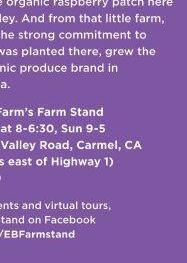




























































































































 BY CAMILLA M. MANN PHOTOGRAPHY BY PATRICE WARD AND CAMILLA M. MANN
BY CAMILLA M. MANN PHOTOGRAPHY BY PATRICE WARD AND CAMILLA M. MANN









































































































































































































































































































































































































 BY ELIZABETH LIMBACH • PHOTOGRAPHY BY CRYSTAL BIRNS
BY ELIZABETH LIMBACH • PHOTOGRAPHY BY CRYSTAL BIRNS





















